361 MAY 2025
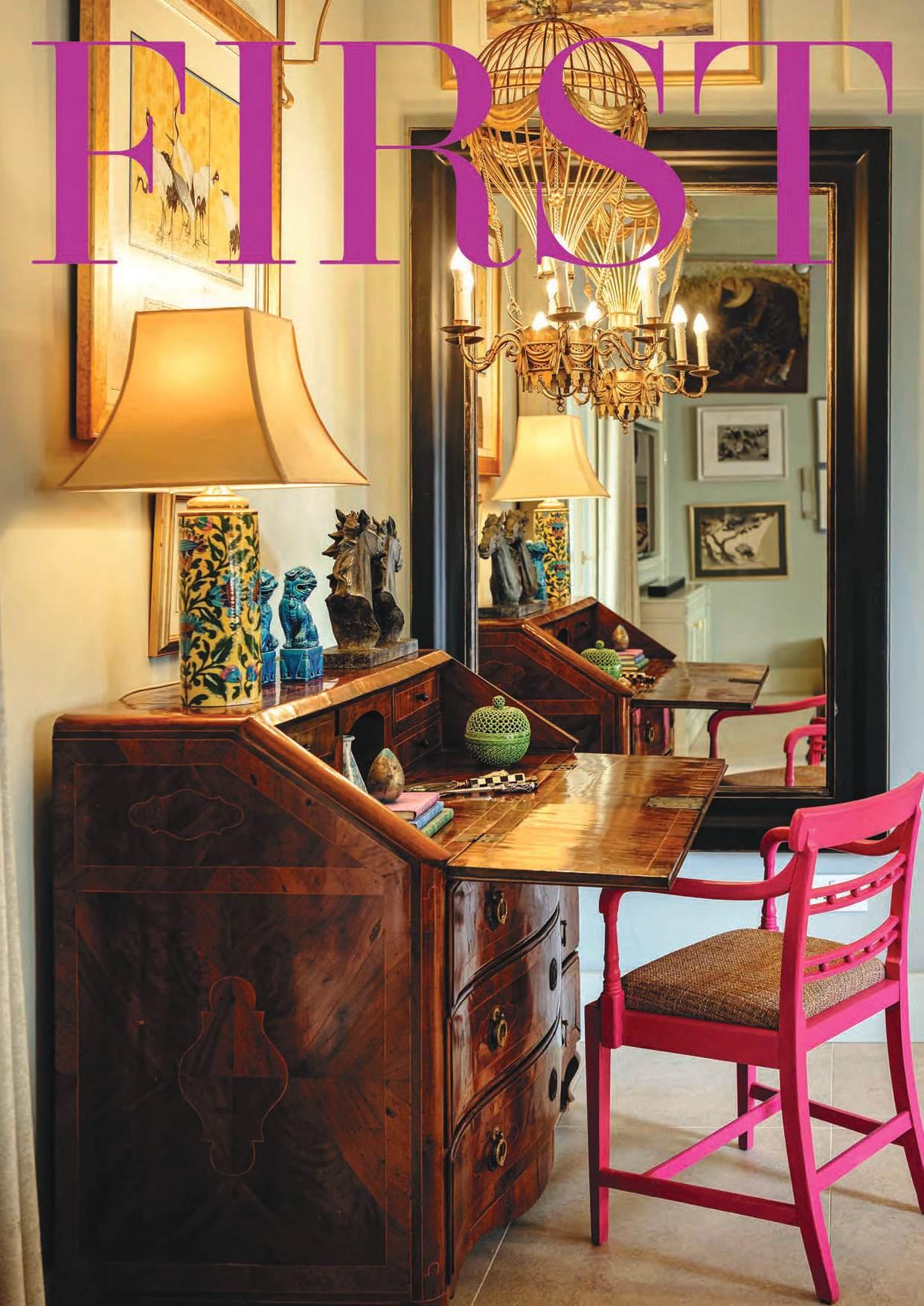

361 MAY 2025


“And so with the sunshine and the great bursts of leaves... I had that familiar conviction that life was beginning over again with the summer.”
F. SCOTT FITZGERALD, THE GREAT GATSBY

“PEACE
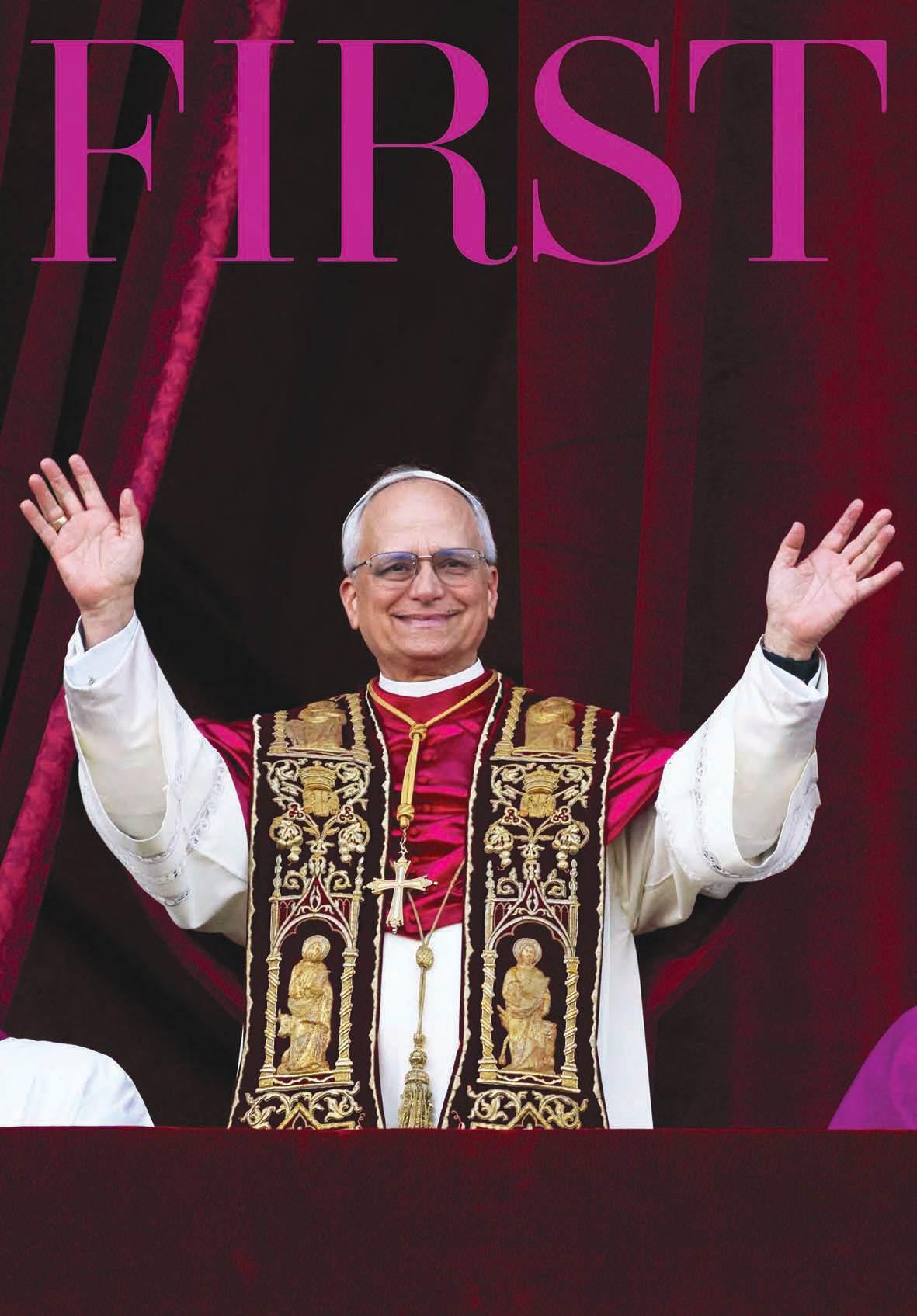
HABEMUS PAPAM!
eace be with you all! Beloved brothers and sisters, this is the first greeting of the Risen Christ, the Good Shepherd who has given his life for the flock of God. I, too, would like this greeting of peace to enter your hearts, reach your families, to all people, wherever they may be, to all peoples, to all the earth. Peace be with you!” –Pope Leo XIV. His first words to the crowd gathered in St. Peter’s Square after his election as the 267th Bishop of Rome.



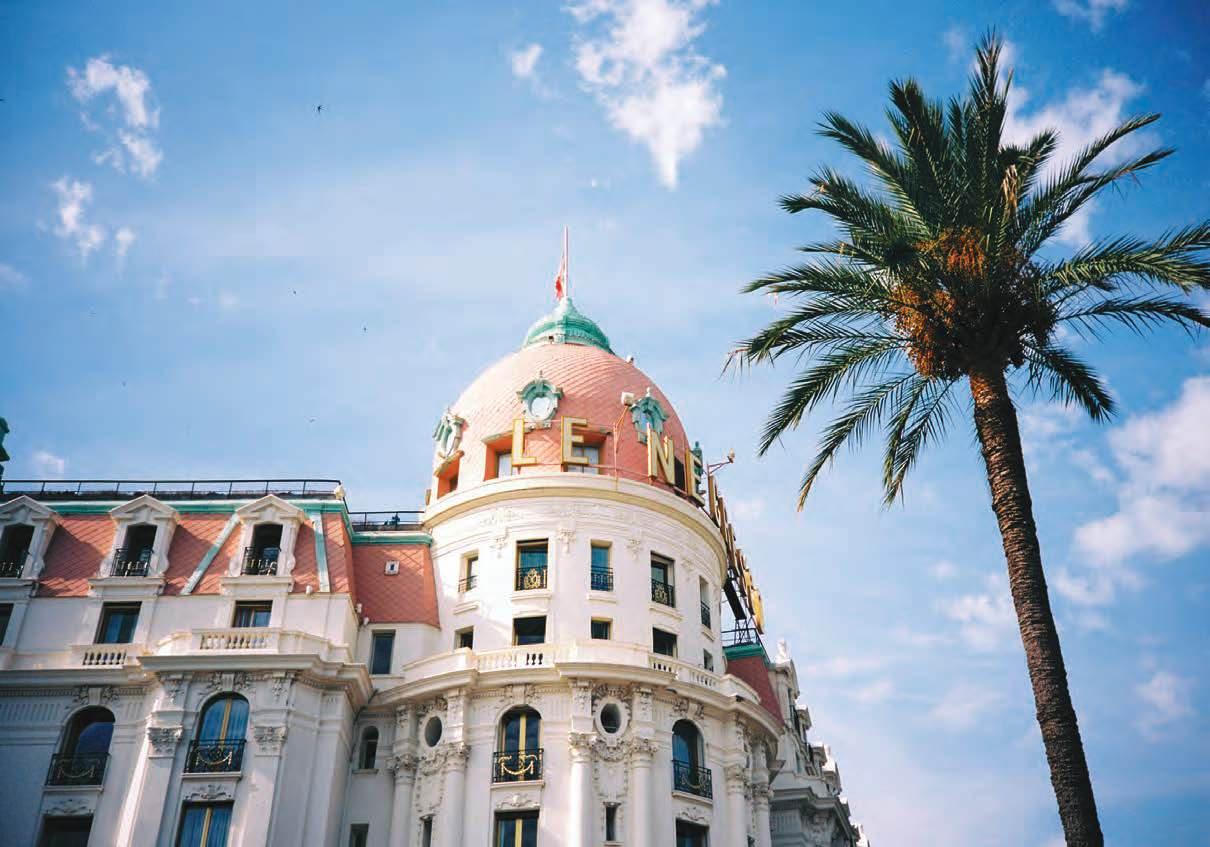

8
LA DOLCE VITA
The Art Of Riviera Living. Undeniably French: Inside Le Negresco.
18 FAST CARS
Gilded Gears and Grand Designs. The Goodwood Festival of Speed.
24 INTERIORS
Country Reimagined. A Contemporary Transformation by Pippa Toledo.
37 ARCHITECTURE
Lembut.
A Modern Home in a Historic Core by CVC Architecture Studio.
47 EXHIBITION
Emvin Cremona. The Glass Collage.
54 HABEMUS PAPAM
Pope Leo XIV. “Peace be with you all!”
64 AWARENESS
Adjectives and the Human Heart.
69 MELITENSIA
Celebrating 50 Years of the National War Museum.
72 GASTRONOMY
“Paris is always a good idea.”
The Art of Dining in the City of Light.
85 HEALTH & WELLBEING
Can Reversing Diabetes Protect Your Brain? 90 STYLE
Olivier





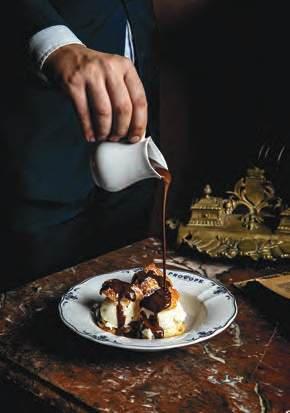
GASTRONOMY.

“Blue has no dimensions, it is beyond dimensions, whereas the other colours are not... All colours arouse specific associative ideas, psychologically material or tangible, while blue suggests at most the sea and sky, and they, after all, are in actual, visible nature what is most abstract.”
Yves Klein
WHIMSICAL, UNDENIABLY FRENCH: INSIDE LE NEGRESCO
A stroll along the Promenade des Anglais offers more than sea views and Riviera glamour. In the grand salons of Le Negresco, where Belle Époque meets contemporary flair, Nice reveals a layered identity 0 at once refined, rebellious, and quietly resurgent.
Main photography courtesy Le Negresco. Photography this page Nick Page.

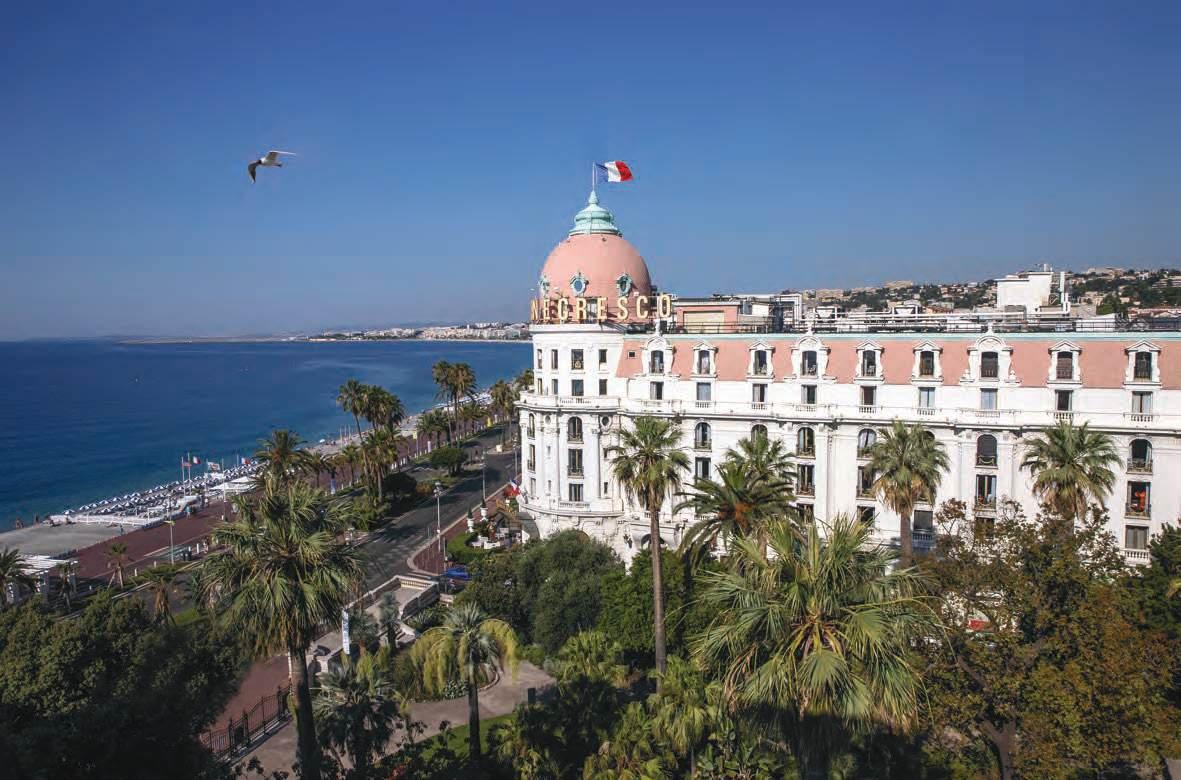
the
origins
The promenade, a palm-lined sweep of elegance that curves along the
the English aristocracy, who descended upon Nice in droves during the 19th century. Below: The Salon Royal, crowned with a stained-glass dome designed by
workshop. In the centre hangs an imposing chandelier in Baccarat crystal – 4.6 metres high, made with 16,800 crystals. It was originally ordered by
Photography

There are few places where the Mediterranean’s sensuality is matched by architectural flourish, historical intrigue and unapologetic flair quite like Nice. With its wide boulevards and baroque domes, palms that quiver in the breeze and the hazy blue light that inspired the likes of Matisse, Chagall and Yves Klein, the city has always danced to an unhurried rhythm. At the heart of it all–facing the Baie des Anges with the authority of a grande dame– is Le Negresco, a hotel unlike any other.
Built in 1913 and crowned with a candyfloss-pink dome, Le Negresco has become as much a part of Nice’s identity as the Promenade des Anglais itself. The palmlined promenade, that curves along the seafront, owes its origins to the English aristocracy, who descended upon Nice in droves during the 19th century, lured by the winter sun and the belief that sea air could curealmost anything. The British left more than parasols and romances behind; they helped define the Riviera’s distinct brand of casual grandeur.
Into this cultural and climatic mix stepped Henri Negresco, a Romanian-born hotelier with a vision: to create a palace worthy of kings, queens and captains of industry. When Le Negresco opened its doors in 1913, it did so with such immediate success that within its first year it had already turned a substantial profit. War would interrupt that early promise-its Belle Époque salons turned into wartime wards– but the idea behind it endured.

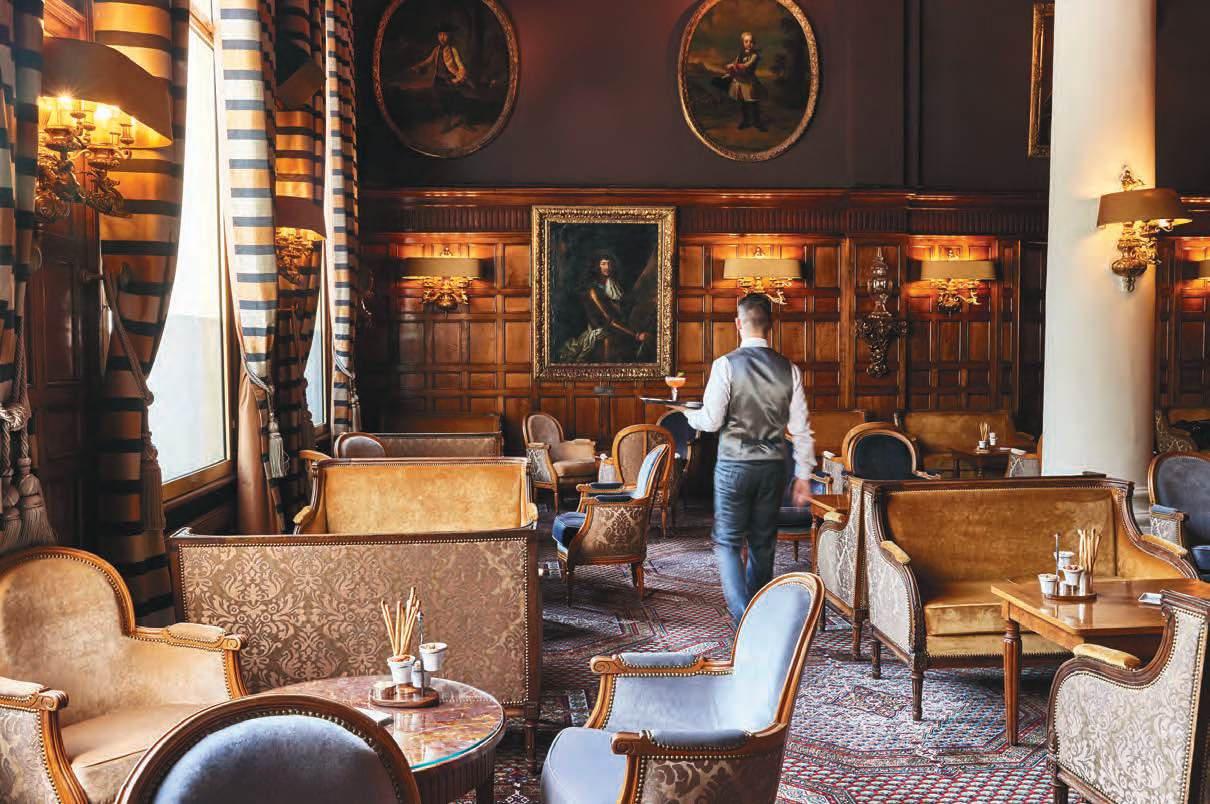
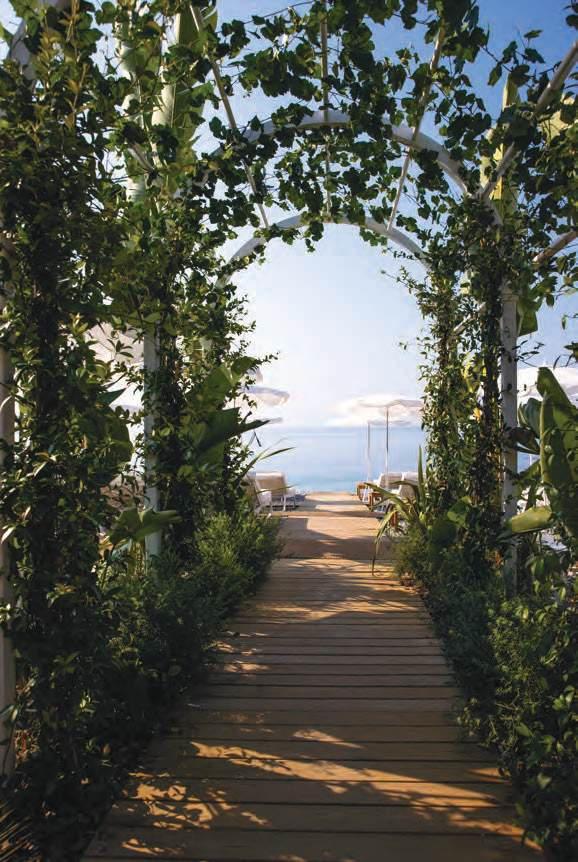
Today, more than a century later, Le Negresco remains a one-of-a-kind experience. Neither chain hotel nor relic, it feels singularly alive, thanks in large part to the late Jeanne Augier, who owned the hotel from 1957 until 2019. Madame Augier, a committed collector and connoisseur, transformed Le Negresco into an art-filled celebration of French style and history. Over 6,000 works now populate its halls and salons, from antique portraits to contemporary sculpture, with an eclecticism that refuses to be tamed.


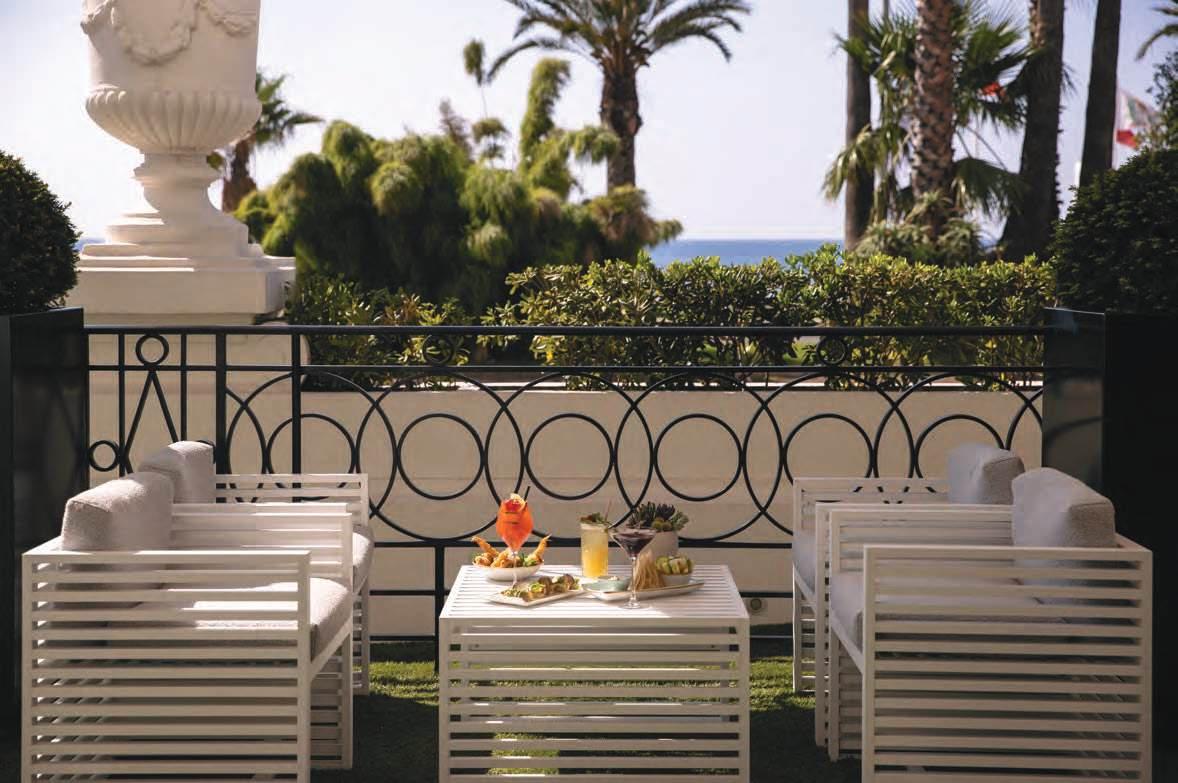
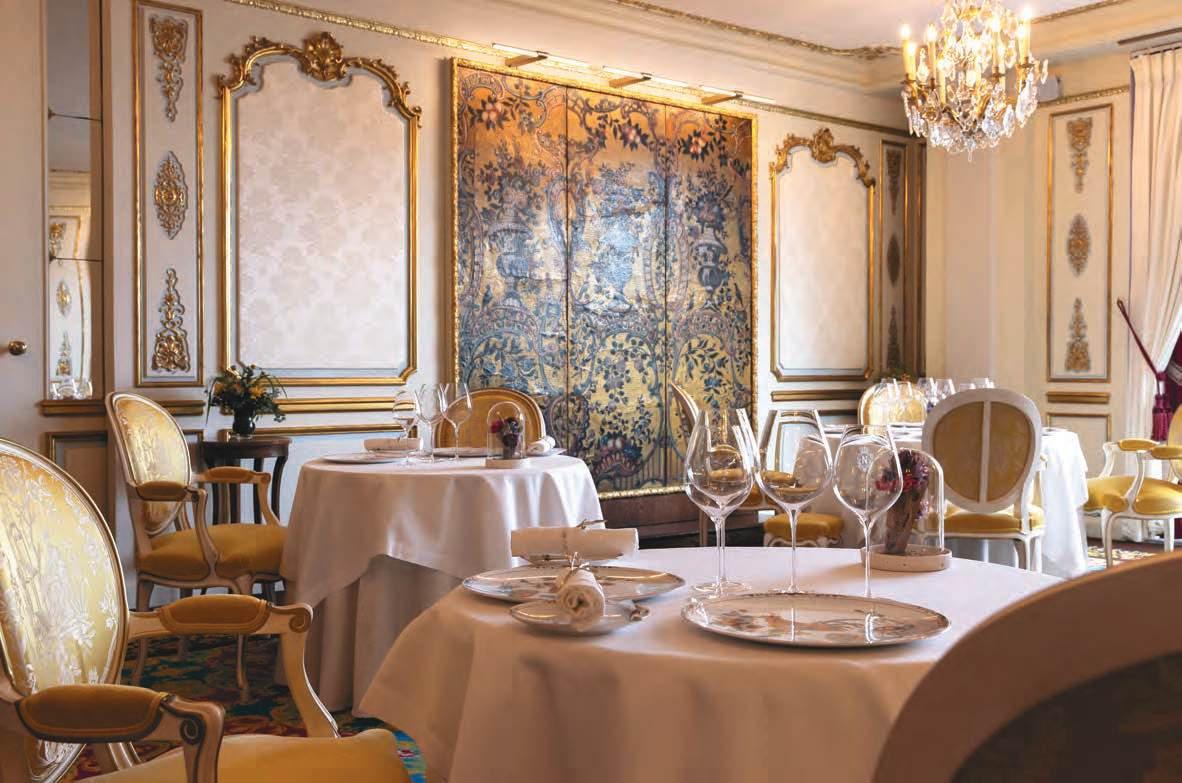
Below left: Sea View Junior suites have everything going for them: the location, the decoration and the view – silk wall coverings, elegant wood furniture and comfortable velvet. Below right: Suite Marie Antoinette. With its blue and golden hues, the salon recreates the most vibrant moments of the late 18th century. Photography Gregoire Gardette, courtesy Le Negresco.
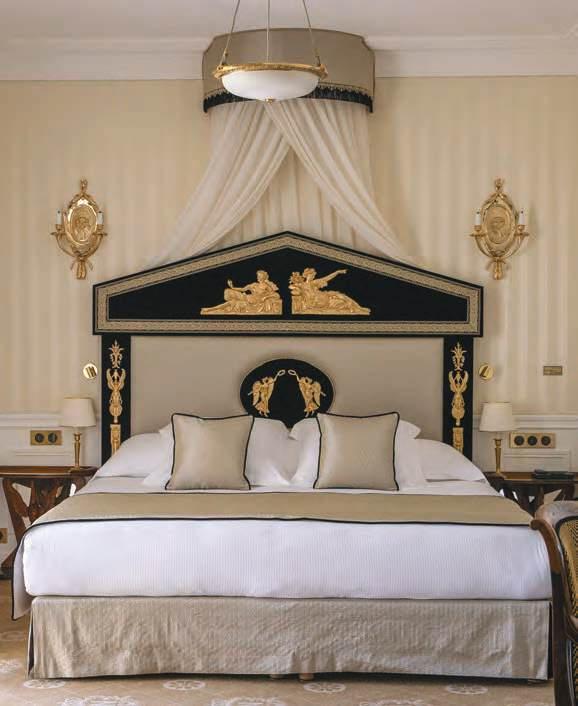
Each of the hotel’s 102 rooms and 26 suites is unique, with interiors that span centuries– Louis XIII tapestries, Empire-style four-posters, and haute couture-inspired upholstery. The effect is theatrical, yet intimate – one suite honours the Empress Joséphine; another is dedicated to Madame de Pompadour. There are gilded chairs, marquetry dressers, velvet headboards, walnut-panelled bars and 17th-century tapestries– each room a vignette within the vast stage of the hotel.
Yet for all its romance and historical allure, Le Negresco is very much of its time. Its Michelin-starred restaurant, Le Chantecler, is headed by Virginie Basselot, one of the rare women to hold the title Meilleur Ouvrier de France. Her cuisine, defined by restraint, innovation and precision, offers a modern counterpoint to the building’s opulent décor. The brasserie, La Rotonde, features a merry-go-round theme with whimsical flair, while the recently opened N Le Spa adds a contemporary layer of wellness.
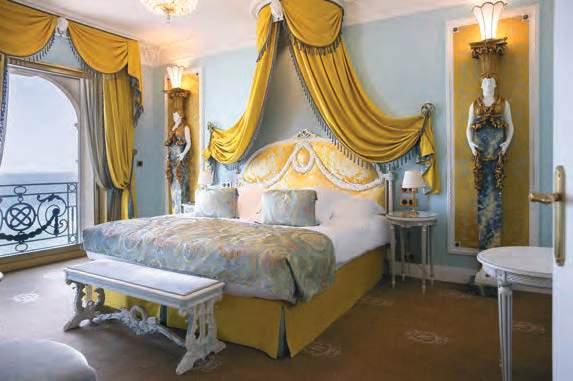
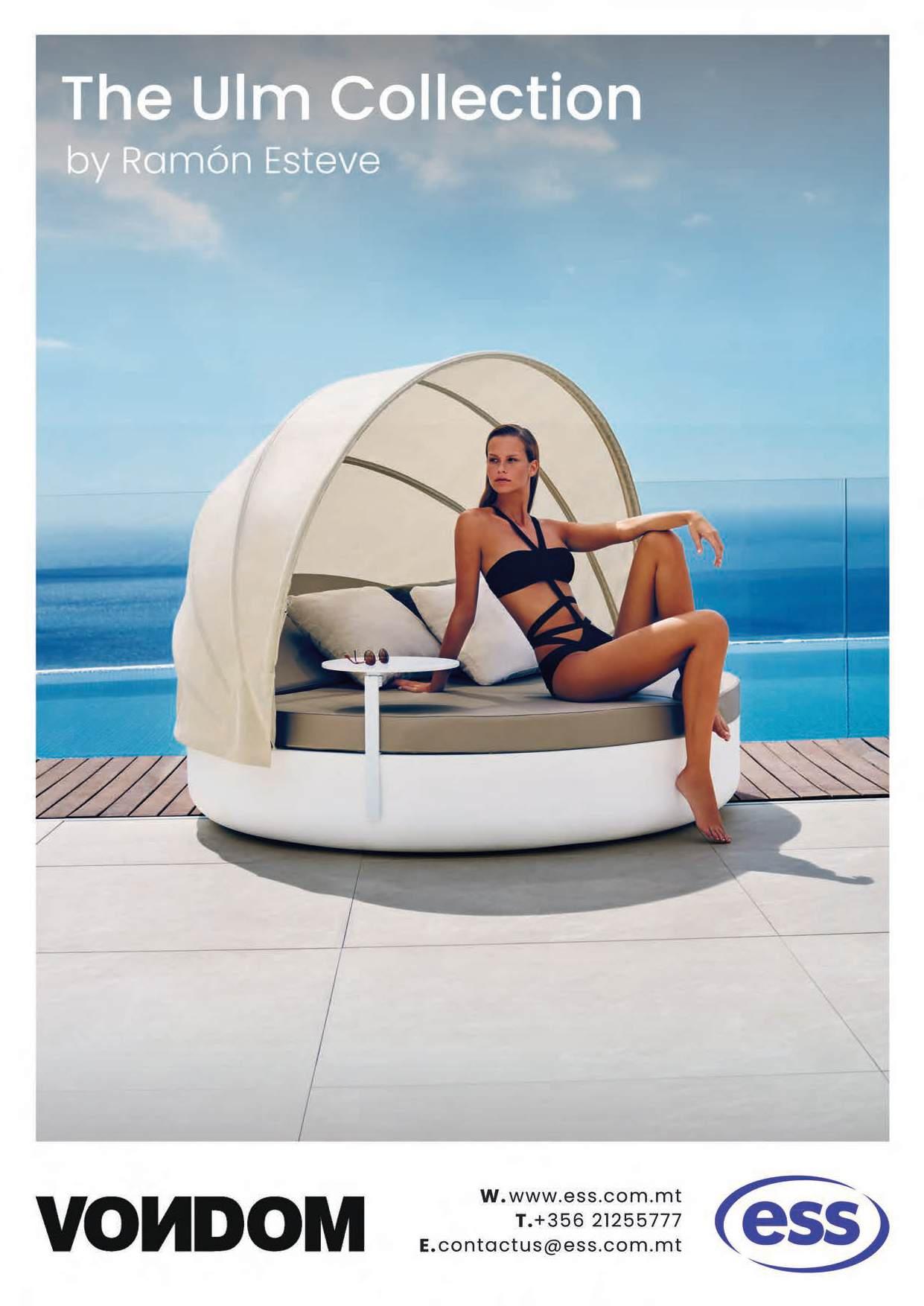


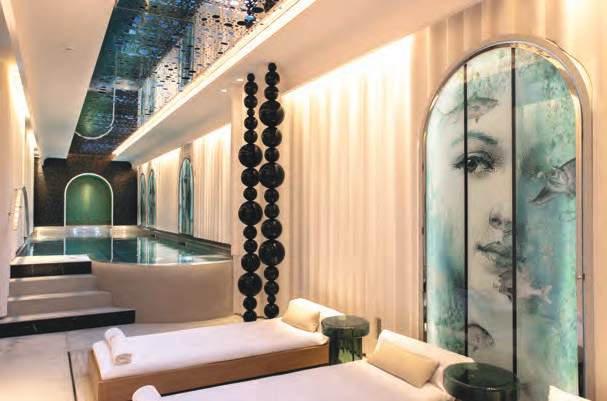
Even the hotel’s bars echo the play between past and present. Le Bar 1913, with its original walnut panelling, serves cocktails under the glow of centuries-old chandeliers. Come summer, Bar Versailles opens onto a terrace overlooking the Mediterranean, its soundtrack veering from jazz to pop as the sun dips behind the Colline du Château.
The views from here are steeped in symbolism. For artists such as Yves Klein, born in Nice in 1928, the city’s particular shade of blue became something of a muse. His patented “International Klein Blue” attempted to capture not just the colour of the sea, but its feeling: ecstatic, immersive, infinite. That sense of visual intensity lingers in Nice– in the light that bounces off the stuccoed façades, in the way sky and sea blur into a single chromatic field. This idea of capturing emotion through aesthetics is everywhere at Le Negresco. The Royal Salon, crowned with a stained-glass dome designed by Gustave Eiffel’s workshop, is a riot of light and space, while the corridors often resemble galleries more than hotel hallways. Films have been shot here, deals struck, romances ignited. It is no coincidence that Greta Garbo, the Beatles, Jean Cocteau and Salvador Dalí all passed through its doors. Each found something of themselves reflected in its gilded mirrors and mischievous charm.
Still independent, still defiantly French, Le Negresco is now classified as a Monument Historique. And yet, it resists the stillness that such status sometimes implies. Environmental credentials have been carefully built into its operation, with Green Key, Ecolabel and Sustainability Leader recognition all part of its current chapter. Behind its rose-tinted dome, the hotel continues to evolve– both preserving and transforming, like the city that surrounds it. Nice has changed since the Victorians first took to its beaches in woollen swimwear, but the allure endures. And as long as Le Negresco continues to welcome guests with both grandeur and wit, the Riviera will never lose its sense of theatre.
Top: Suite Marie Leszczynska captures the magic of the Louis XV epoch. With its spaciousness and soft colours, the salon exudes the elegance of the king’s wife, who was the mistress of elegance at court. Photo Gregoire Gardette, courtesy Le Negresco. Centre and left: The recently opened N Le Spa adds a contemporary layer of wellness. Photography Nicolas Matheus (centre) and Gregoire Gardette (left), courtesy Le Negresco.




As the Festival of Speed returns to Goodwood this July, an extraordinary celebration of Formula 1’s 75th anniversary brings the sport’s icons, innovators and underdogs to the rolling lawns of West Sussex. Photography courtesy Goodwood.

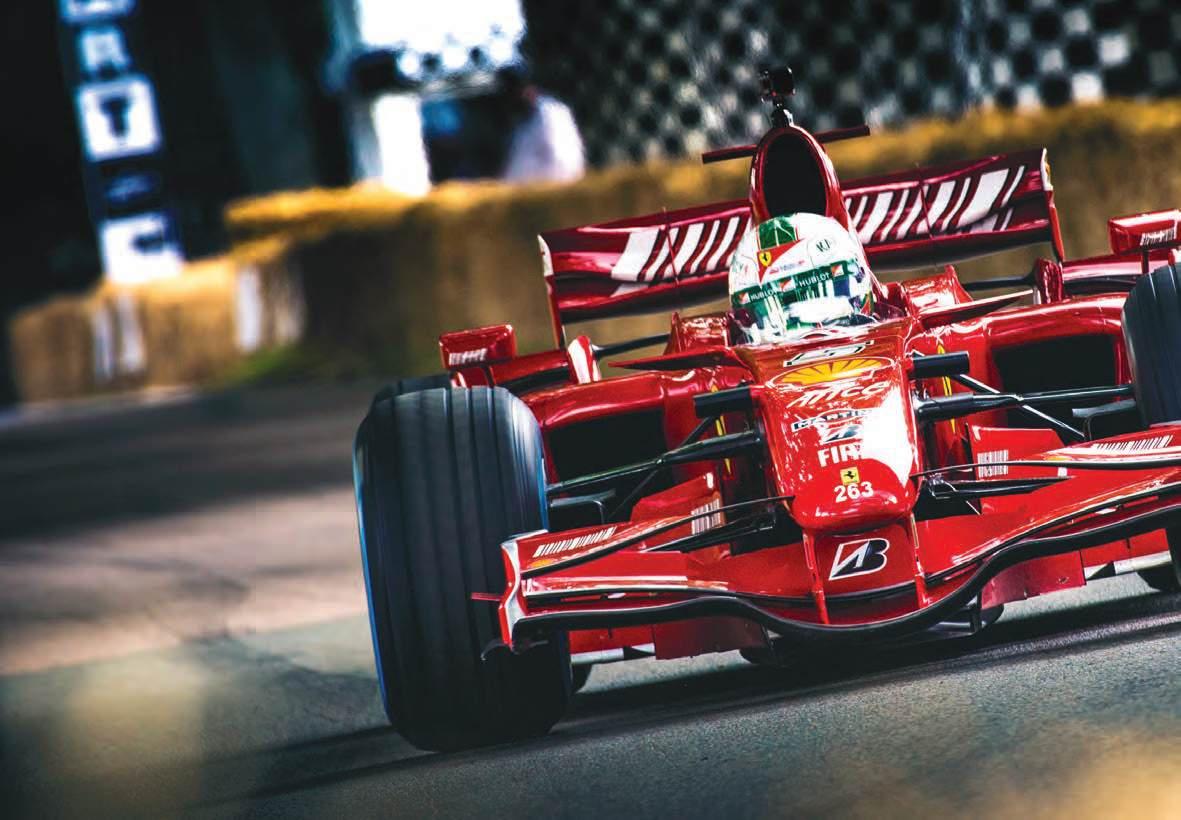


Each summer, a corner of West Sussex becomes the epicentre of mechanical elegance and velocity.
From 10 to 13 July 2025, the sweeping lawns of Goodwood House will once again host the Festival of Speed, a gathering that defies easy categorisation. It is neither race meet nor museum, but something rarer: a curated spectacle of movement, memory and machine. This year’s edition, the 32nd since its inception in 1993, will mark 75 years of the Formula 1 World Championship with what promises to be the Festival’s most ambitious showcase to date.
At the heart of it all stands Charles Gordon-Lennox, the 11th Duke of Richmond, whose family estate provides both the stage and the spirit of the event. A lifelong motoring enthusiast, the Duke has overseen Goodwood’s transformation from a private passion into one of the world’s most significant motoring gatherings. “For over three decades, the Festival of Speed has welcomed some of Formula 1’s most legendary drivers, teams and cars, giving fans unprecedented access to the sport they love,” he says. “This year is no exception… in fact, it’s set to be our biggest celebration of anything ever.”
With over 600 vehicles and motorcycles expected to take part, the event will be particularly focused on Formula 1’s seven and a half decades of technological evolution and competitive drama. The theme for 2025, The Winning Formula –Champions and Challengers, acknowledges both the dominant forces and the determined outsiders that have shaped the sport. No fewer than 80 significant F1 cars will appear across six curated categories – from the pre-championship Prologue era to Champions, Innovators and Underdogs, all the way to the Formula 1 Teams class, which will showcase the cutting edge of the modern paddock.
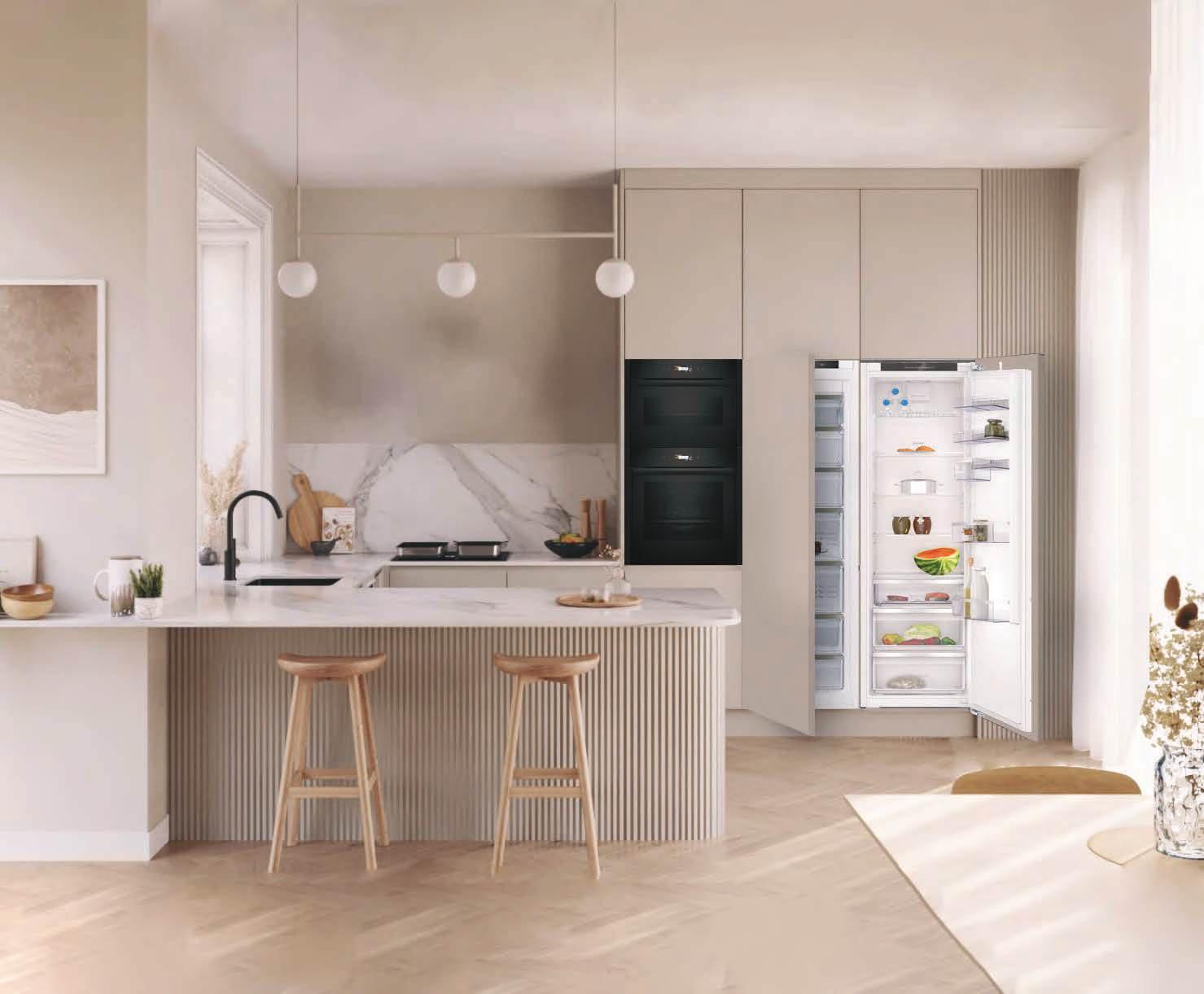
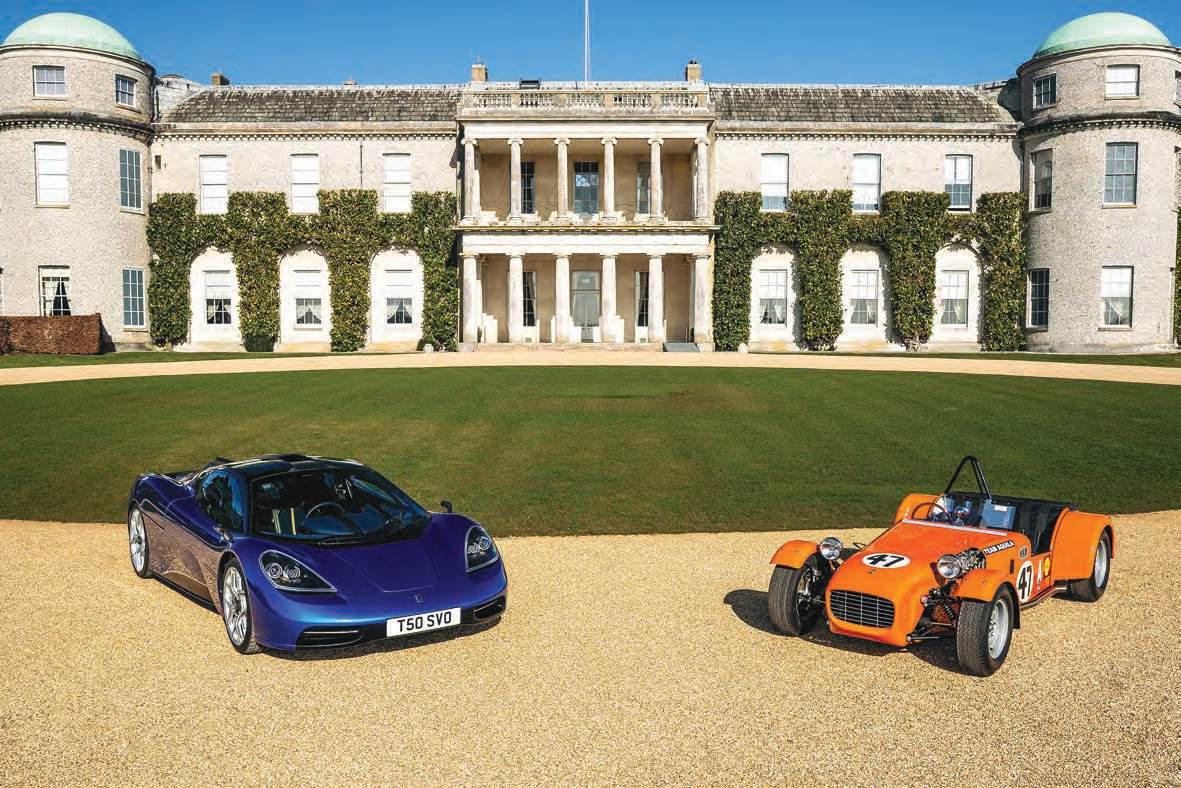
Visitors will see historic machines fired up in the paddocks, then sent rumbling toward the fabled Hillclimb route, often with the very drivers who once piloted them in competition behind the wheel. It’s an unfiltered immersion into the culture of motorsport, where iconic designs from the likes of Ferrari, McLaren, Lotus and Red Bull Racing share tarmac with the engineers and visionaries who shaped their success.
The breadth of names who have appeared at Goodwood over the years reads like an
honour roll of Formula 1: Sir Jackie Stewart, Niki Lauda, Ayrton Senna, Lewis Hamilton, Max Verstappen, Nigel Mansell, Sebastian Vettel. Last year alone saw Vettel take to the Hill in two vintage cars from his personal collection, both powered by sustainable fuel. Verstappen, too, returned in his 2021 titlewinning RB16B to mark Red Bull Racing’s 20th anniversary.
What distinguishes Goodwood, however, is not only the calibre of the machines but the atmosphere. Unlike the closed circuits of Grand Prix weekends, here fans can wander through the pit lanes, speak to drivers, and brush against history in motion. There is a sense of theatre, but also of intimacy –a rare

thing in a sport known for its closed garages and team-only zones.
If Formula 1 symbolises the extremes of speed and precision, Goodwood adds something ineffable – charm, access, character. It is a rarefied place where machines from every era converge in celebration not of nostalgia, but of a collective obsession with pushing boundaries, and sometimes defying them altogether.
The2025Goodwood Festival of Speed presented by Mastercard takes place Thursday 10 - Sunday 13 July. More information and ticketsat goodwood.com.









With a design portfolio that spans both local and international projects, Pippa Toledo is known for her bold use of colour and refined approach to interiors. Her latest commission, a country house refresh, reveals a light, harmonious aesthetic shaped through close collaboration with a long-standing client.
Photography Brian Grech, courtesy Pippa Toledo.
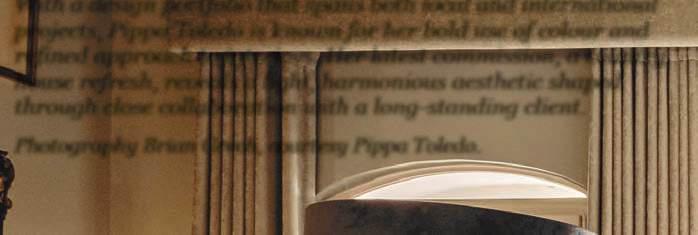
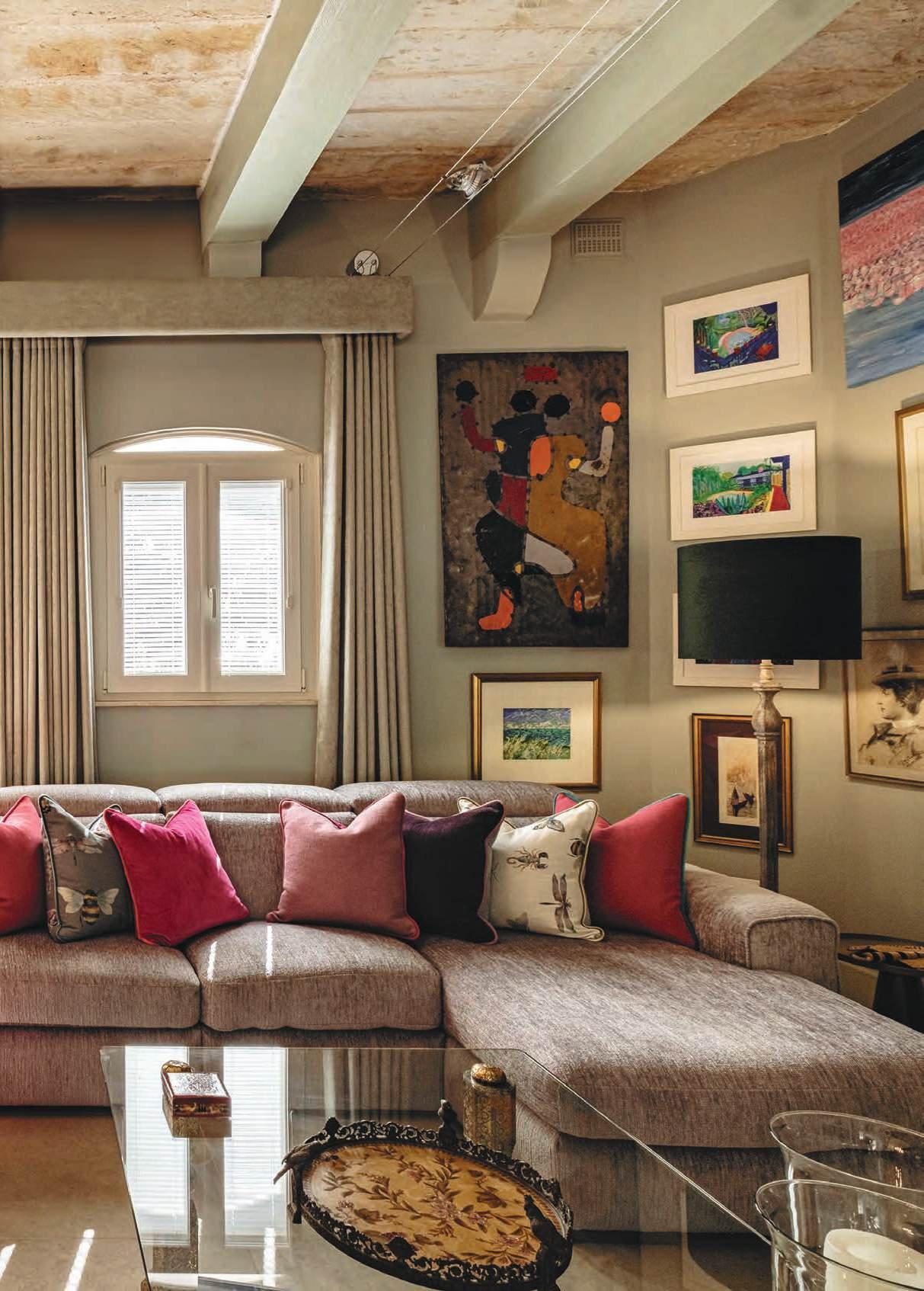
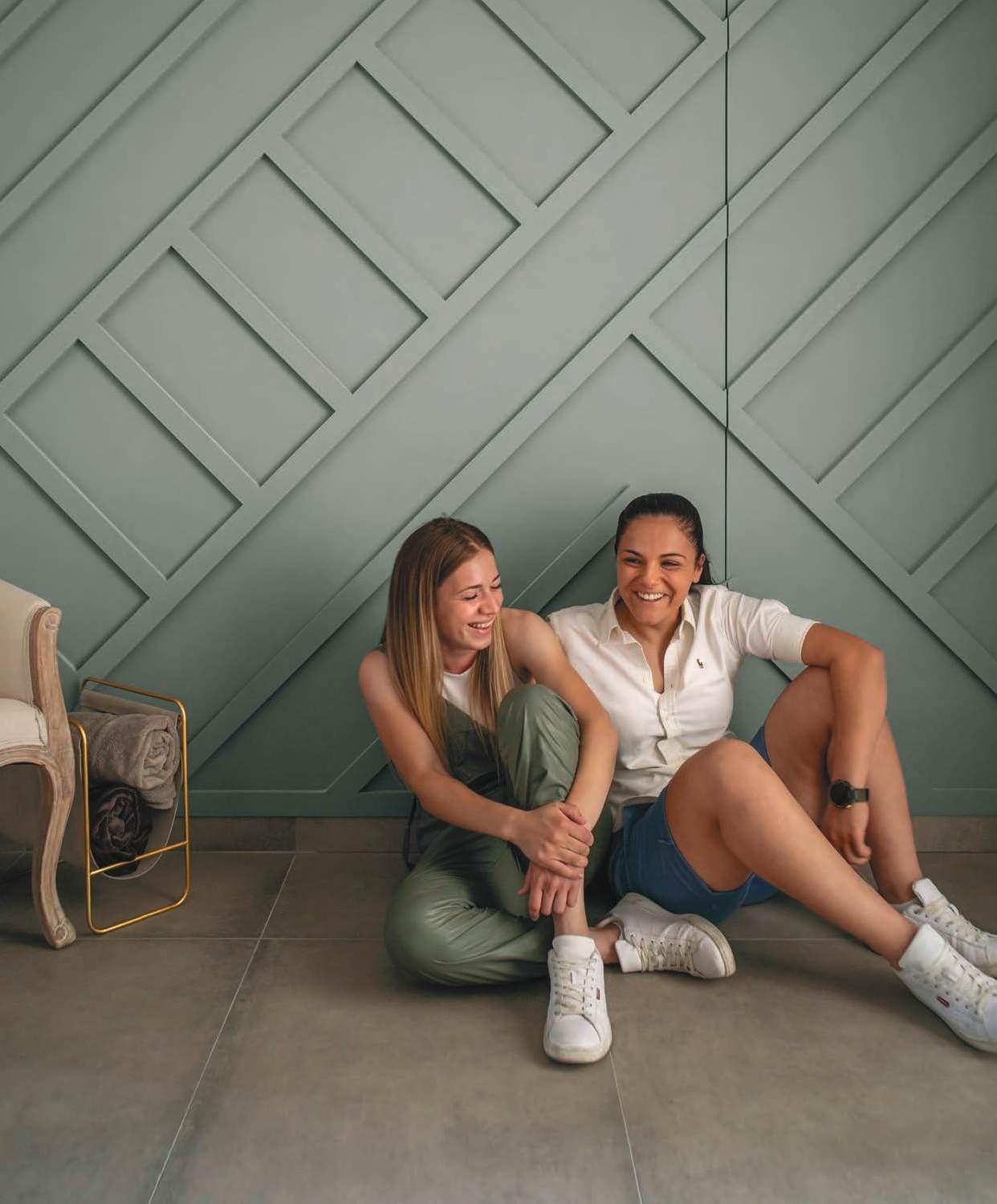

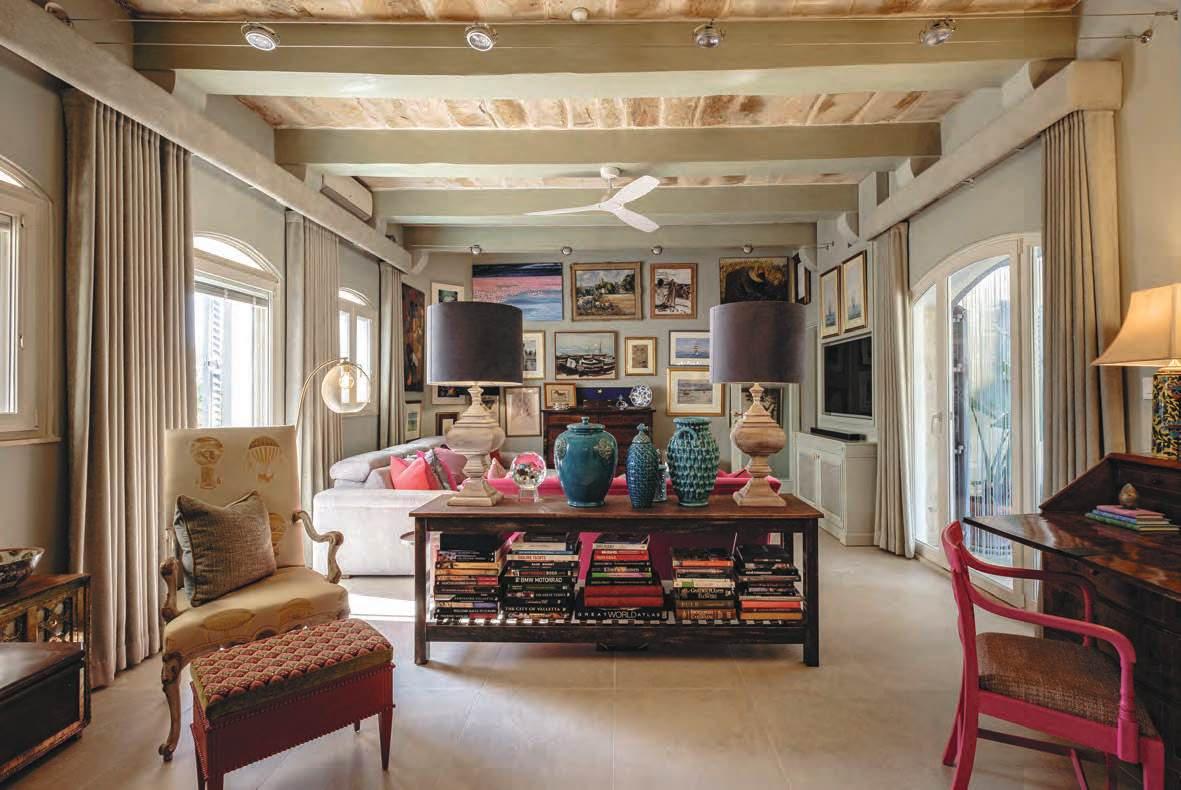
Pippa Toledo has long established herself as one of Malta’s most distinctive voices in interior design, known for her creative instinct and refined aesthetic. With over three decades of experience across art, fashion and interiors, she is known for her fearless use of colour, her confident mix of styles, and her refined, bespoke furnishings that combine flair with function. Yet her work is equally
defined by something less tangible: genuine heart and the joy of home– an instinctive understanding of how a house becomes a home.
This particular project began with a client who had long admired Pippa’s work and was already a returning collaborator. The brief was to breathe new life into a country home that had grown tired over time, but without losing its soul. “The house was looking tired and dated,” the client explains. “The time had come to refresh the look without changing
too much of the existing furniture. I wanted to modernise and harmonise the décor throughout the house, while keeping a sense of my personal style.”
Pippa begins every design process by gaining a clear sense of how her clients live and what matters most to them, ensuring the final design feels both personal and intuitive. In this case, with a long-standing rapport already in place, she had the freedom to take bolder creative decisions throughout the transformation of the country house.
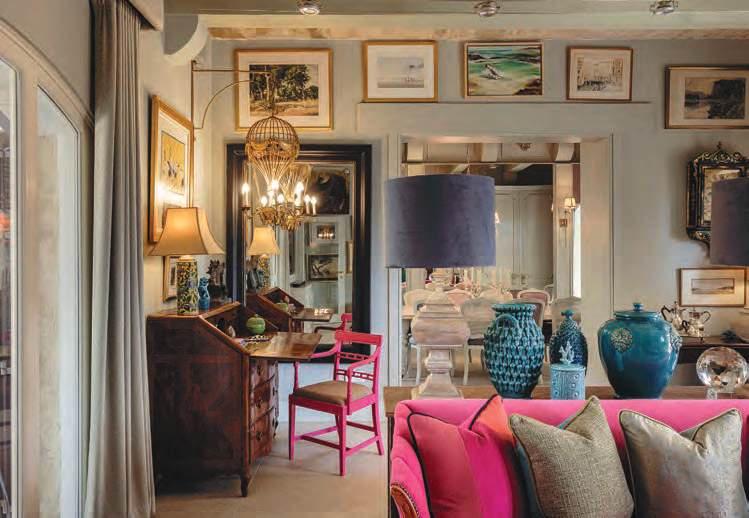
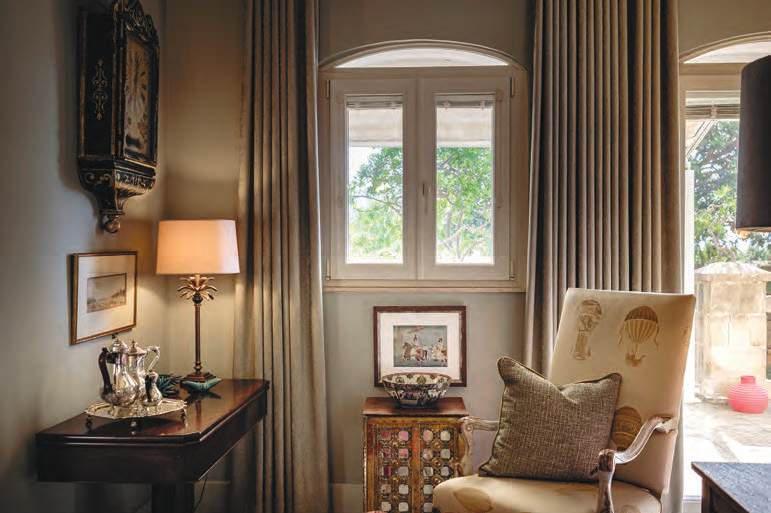
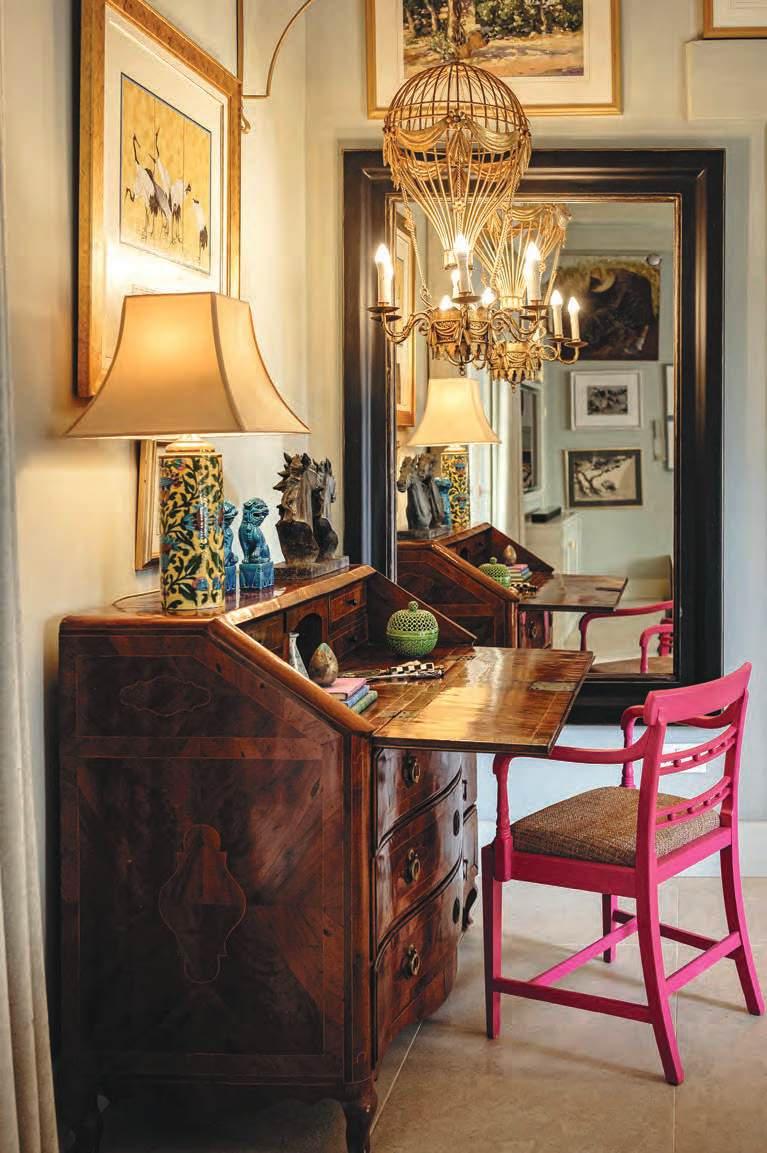

Top left and left: The client wanted to refresh the interiors without changing too much of the existing furniture, which is now showcased against a sophisticated colour palette. Above: French-style wooden dining chairs in a mix of rattan and upholstered finishes bring character to the room, while a whimsical gold chandelier adorned with leaves and crystals adds a touch of country chic warmth. Right: “The dining room needed a lot of storage. We designed and built custom cupboards that fit perfectly into the upper part of the walls, maximising the space without adding bulk.”

The result is a deeply personal and beautifully cohesive home, brought to life through a collaborative process built on mutual trust. “We think a lot alike, and the client is a lovely person to work with. We’re both not afraid of colour and we love to mix things up in unexpected ways. And we wanted to reduce the overall heaviness of the place, to create something more open, elegant and welcoming.”
To shift the mood of the home, Pippa began by transforming its palette. The original interiors were dominated by deep reds, dark wood and a sense of enclosure. Her solution was bold but intuitive: replace the weight of the colour scheme with something altogether lighter, while still keeping the richness of
detail. “I said: ‘Let’s take this in a completely different direction!’”
A softer, more inviting colour scheme replaced the rustic dark wood. Both the beams and the doors were painted to blend into the walls – now a sophisticated sage green to create an airy, cohesive space – while a stonecoloured floor instantly brightened the interiors.Mirrors are placed strategically to reflect both natural light and garden views.
While the heavier elements have been softened, carefully chosen pops of colour, handled with restraint and elegance,were introduced through carefully curated accents, rather than overwhelming blocks. “We spent an enjoyable few hours selecting fabrics and paint colours,” the client says. “It was fascinating to see the design come together with such ease and instinct.”
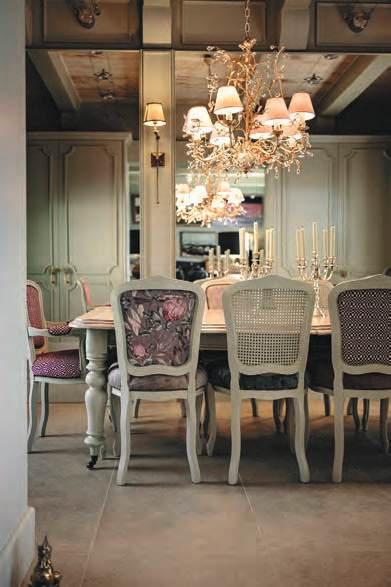


The dining room saw one of the most distinct transformations. Custom-built cabinetry was integrated into the upper walls, providing practical storage while preserving visual openness. “The dining room needed a lot of storage. We designed and built custom cupboards that fit perfectly into the upper part of the walls, maximising the space without adding bulk.”To enhance the connection with the garden, Pippa suggested enlarging a small window. “There was a small window in the dining room,” she explains. “I suggested we expand it to really bring the outdoors in. It was one of the best decisions we made – the natural light floods in and bounces off the wall-to-wall mirror. The entire space feels transformed.”
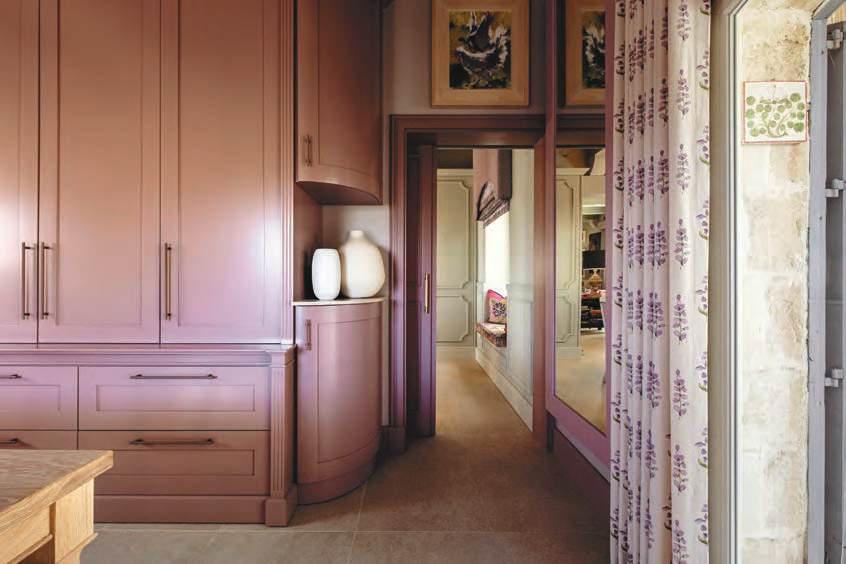
This page: In the kitchen, a distinctive choice of colour pushed convention in a graceful direction. A dusty pink hue now defines the room. “Few people would go for a dusty pink kitchen,” Pippa admits with a smile. “But it really worked.”

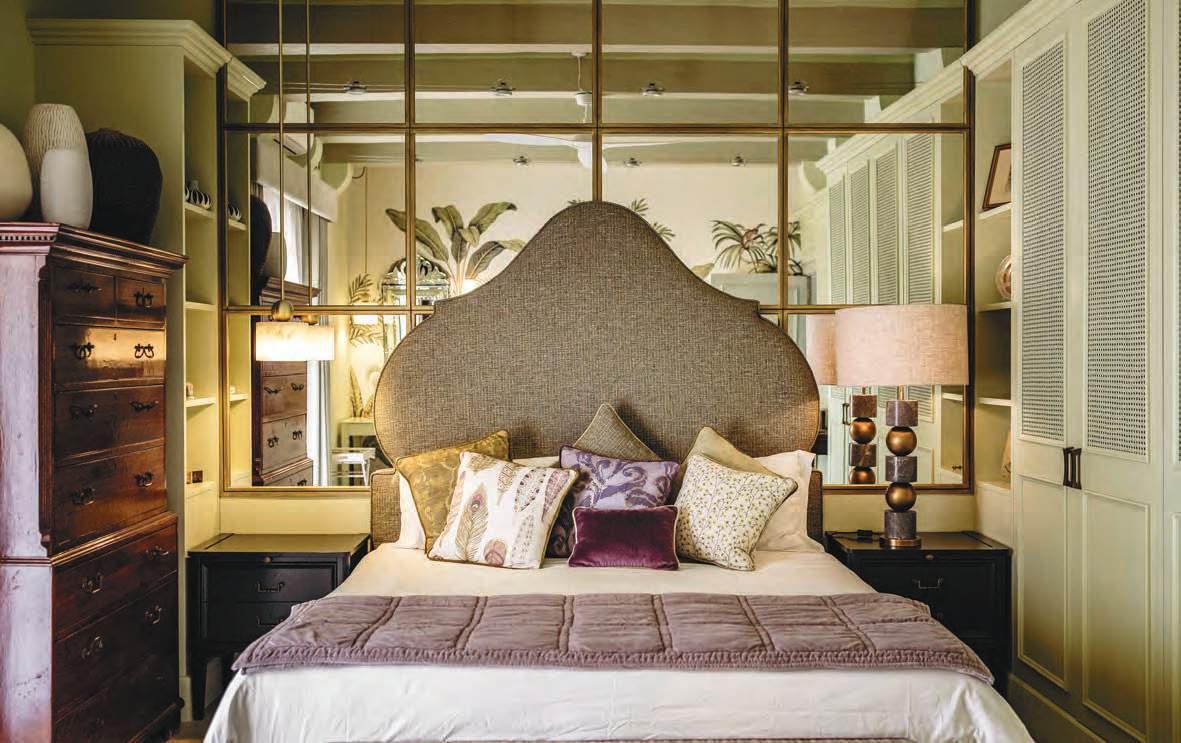
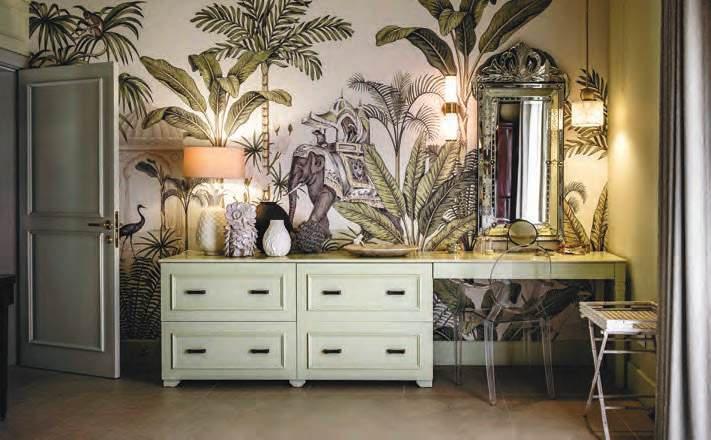
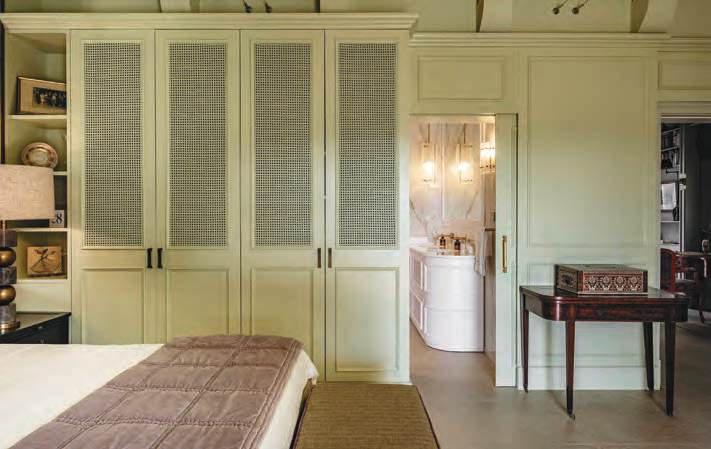
In the kitchen, a distinctive choice of colour once again pushed convention in a graceful direction.
A dusty pink hue now defines the room.“Few people would go for a dusty pink kitchen,” Pippa admits with a smile. “But it really worked.”
The master bedroom reveals another layer of design confidence. Here, a statement head board adds height and drama to the space, while a mirrored backdrop reflects the eye-catching, foliage-themed wallpaper on t he opposite wall. “Not everyone would dare to have a mirrored headboard, but the client trusted the vision, and they absolutely loved it.”
Starting from: €12,450*
*Price including 2025 government grant and scrappage scheme.




Above: A palette of textured neutrals and tropical wallpaper creates a serene corner for repose, where an upholstered daybed layered with cushions invites lingering naps and leisurely reads.
Below left: A painting by Pippa herself anchors the master ensuite bathroom with a personal touch, positioned above a sculptural freestanding tub for a refined yet intimate focal point.
Below right: In the master ensuite, rattan-fronted sink cabinetry echoes the wardrobe detailing in the adjoining bedroom, creating a subtle thread of continuity.

The feeling is mutual. The client, who even chose one of Pippa’s own artworks for the bathroom, describes the finished home with enthusiasm. “I love the harmony of colour and the flow throughout the house. Pippa has a distinctive way of working with bold combinations that feel both confident and quietly balanced – that are striking and yet also createa calm and soothing atmosphere.”
For Pippa, this was a project that unfolded with ease – a dream collaboration. “I loved every moment of working on this house. The best projects happen when there’s trust and a shared vision between designer and client – and this was definitely one of them.”
To view more of Pippa Toledo’s work, visit www.pippatoledo.com


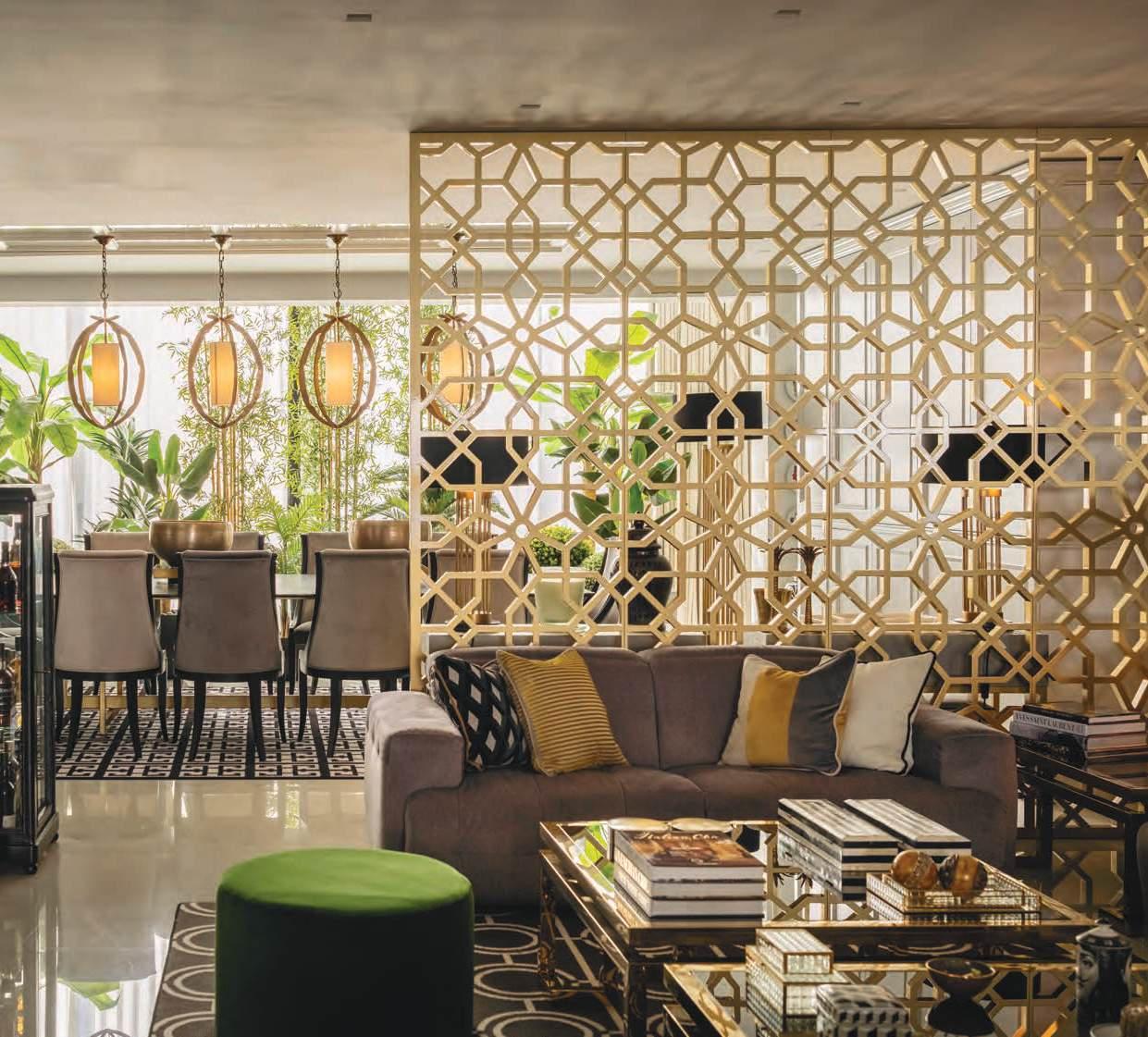
Create the space of your dreams with a complete suite of interior design services tailored just for you. Specialising in high-end residential and boutique commercial projects, with full-scale design solutions from concept to completion.
Personalized consultation | Innovative concepts | Comprehensive planning Mood boards | 3D Renderings | Lighting design | Custom furniture design Soft furnishings | Wide range of fabrics for curtains, cushions, upholstery and carpets.








Tucked away within the traditional village core of a Maltese town, a narrow façade conceals a strikingly contemporary family home designed for a passionate car collector. Known as Lembut – which means funnel in Maltese –a playful nod to the site’s widening shape –the property replaces a former commercial garage, reimagined by CVC Architecture Studio into a residence that blurs the boundary between living space and personal passion.
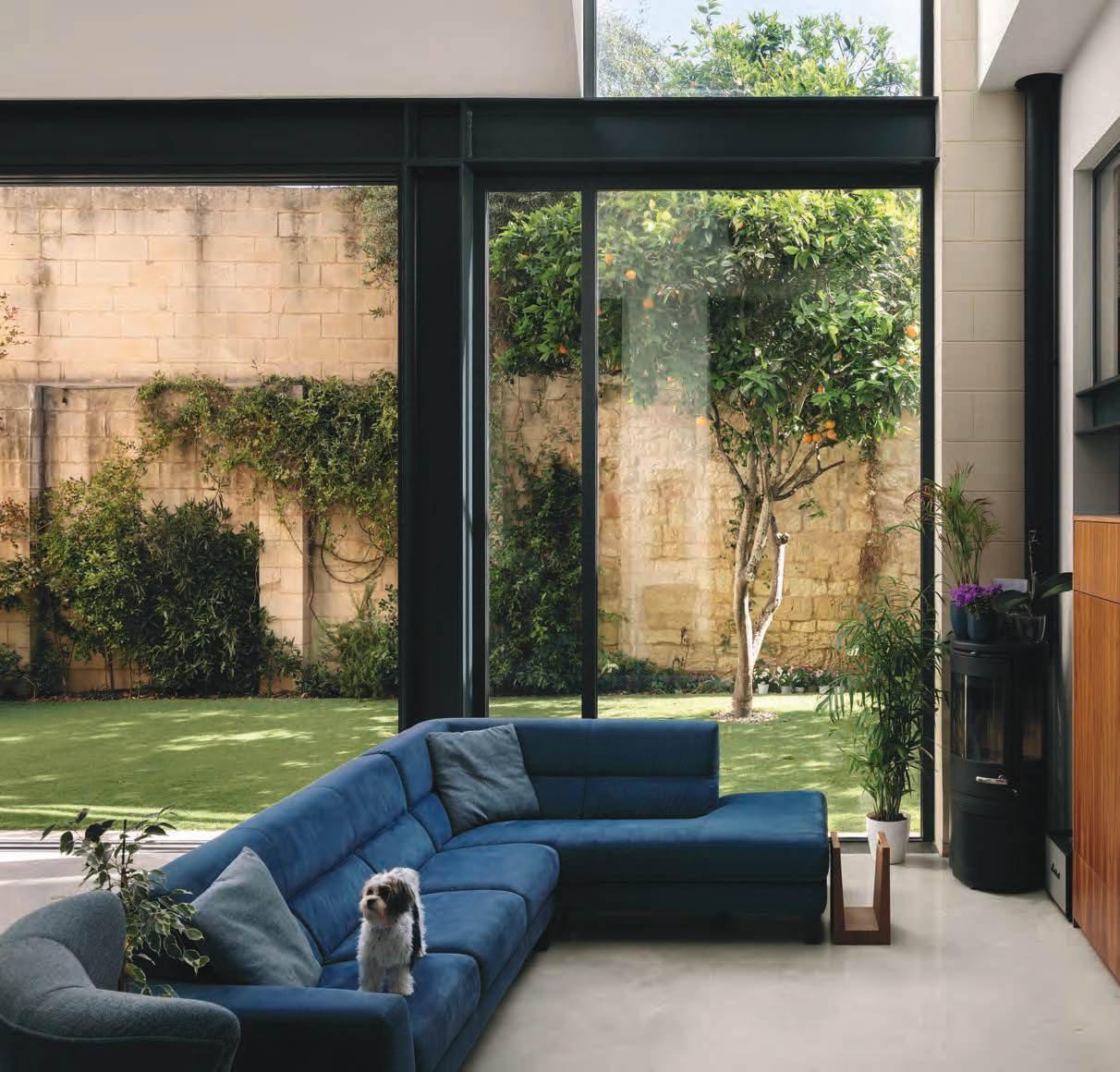


Top and left: The brief for this project called for a comfortable home for a couple and their three children, with space to accommodate a collection of classic cars. Double-height ceilings draw the eye to citrus trees at the rear. Above: The elevated car gallery, visible from the open-plan living spaces below, transforms the act of collecting into a part of daily family life.
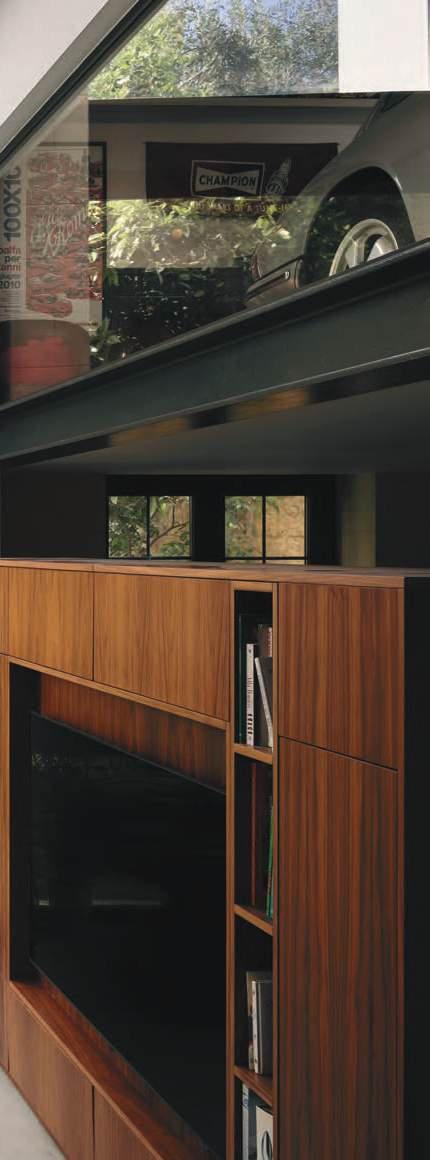


The brief called for a comfortable home for a couple and their three children, with space to accommodate a collection of classic cars. The site itself had previously housed a commercial garage, incongruously located within a traditional village core, and was set to be demolished to make way for the new residence. What began as a logistical challenge – an awkwardly shaped plot on a backfilled quarry with limited access –became an opportunity for architectural ingenuity. The original idea to create an underground garage was ruled out when
excavation proved impossible, prompting the studio to turn the very heart of the home into a celebration of automotive design.
CVC Architecture Studio approached the site with sensitivity to its context. The street-facing façade, just over three metres wide, is quietly assertive – a traditional remissa-style doorway preserves a visual continuity with the surrounding streetscape, while concealing the layered composition within. Behind this entryway, a series of materials –timber cladding, and dark customdesigned doors for the entry and garage –begin to hint at the refined modernism that unfolds inside.
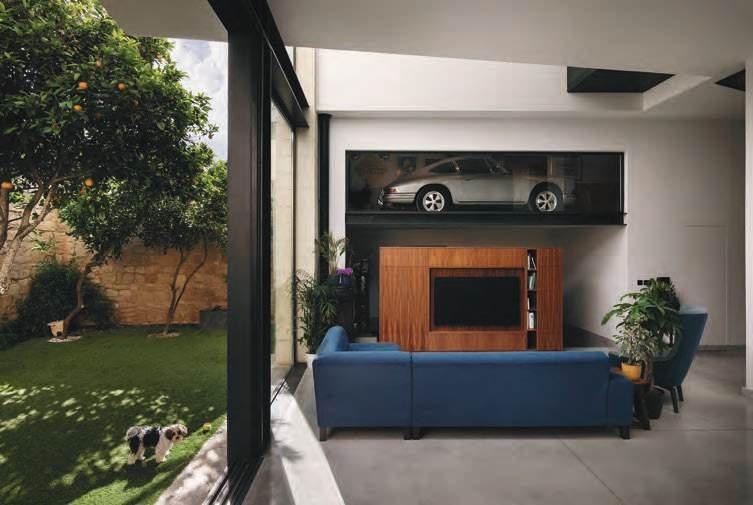
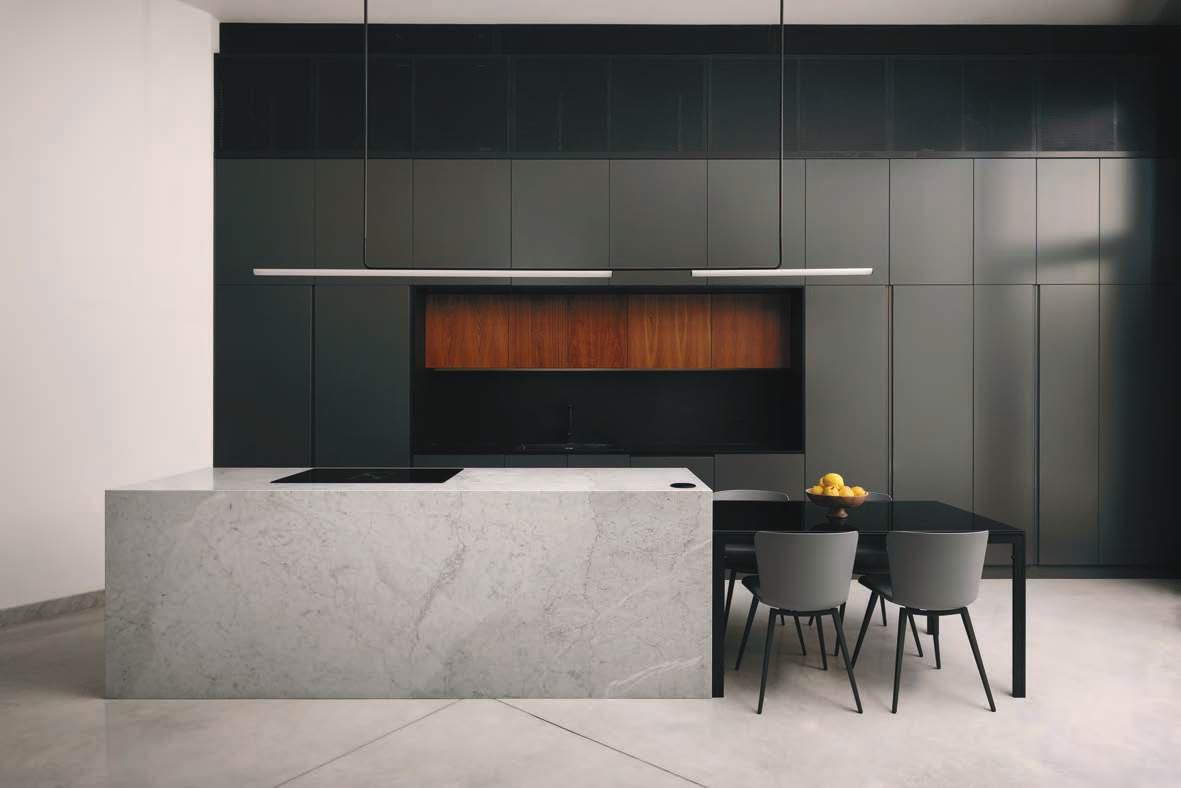
Stepping into the interior reveals a space grounded in clarity and proportion. Verticality is used to dramatic effect: double-height ceilings draw the eye to citrus trees at the rear, remnants of the original garden that
anchor the new design to its past. Fourmetre-high apertures usher in natural light, dissolving the divide between interior and exterior while framing the mature trees beyond like a living artwork.
At the centre of the house lies its defining feature: a car gallery raised on a bespoke lift system. Rather than relegating the collection

to a separate garage, CVC positioned it as a central component of the home’s visual rhythm. The elevated display, visible from the open-plan living spaces below, transforms the act of collecting into a part of daily family life. Here, architectural function and personal narrative converge with elegance and ease.
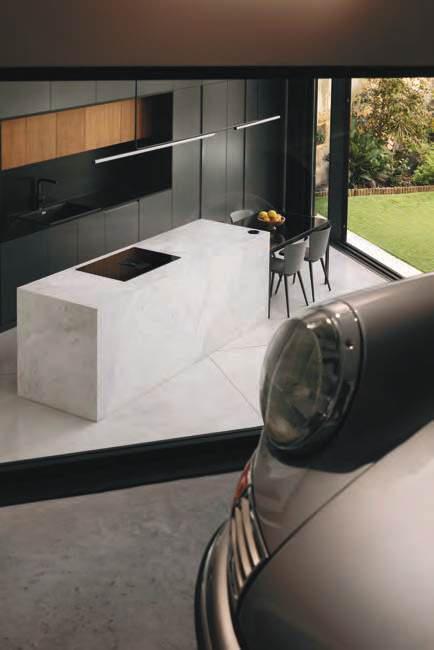
This page: A sculptural Carrara marble island anchors the kitchen, complemented by dark cabinetry and stained timber accents that lend warmth to the monochrome palette. Subtle yet sculptural lighting, including a sleek pendant supplied by GLOW LIGHTING DESIGN suspended above the marble island, lends a sense of intimacy to the kitchen while echoing the clean geometry of the cabinetry and worktops.


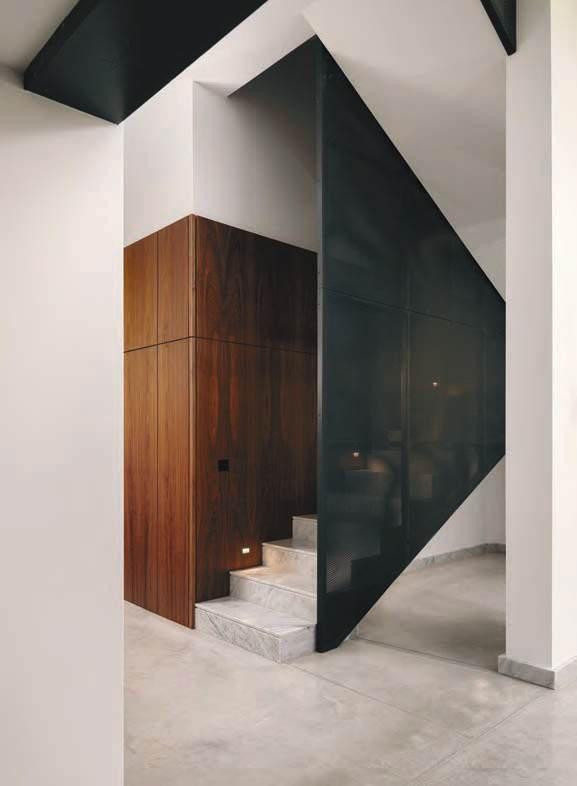
Above left and right: A bespoke entrance hall unit by CUSTOM WORKSHOP MALTA pairs a dark finish with rich American walnut, offering concealed storage and a built-in bench. The design extends into a flush door and continuous walnut wall cladding that ascends the staircase, setting a sleek, contemporary tone from the moment one steps inside. Below: In the guest bathroom, CUSTOM WORKSHOP MALTA created both the American walnut wall cladding –incorporating discreet top storage with seamless touch-latch doors –and the black-sprayed stainless steel vanity, finished with a crisp Bianco Carrara marble top for contrast to the warm wood palette. For both the entrance hall and guest bathroom the walnut panels are meticulously bookmatched, with the grain running in continuous alignment from top to bottom for a seamless, elegant finish.

The ground floor follows the widening contours of the site, gradually opening into a generous living and kitchen space overlooking the garden. A sculptural Carrara marble island anchors the kitchen, complemented by dark cabinetry and stained timber accents that lend warmth to the monochrome palette. Subtle yet sculptural lighting, including a sleek pendant suspended above the marble island, lends a sense of intimacy to the kitchen while echoing the clean geometry of the cabinetry and worktops. A thoughtfully designed custom TV unit delineates the living and dining zones, offering a sense of intimacy without interrupting the flow of the space.
Upstairs, the private quarters take full advantage of the surrounding village views, oriented towards scheduled buildings and green enclaves. A secondary living area has been carved into the circulation space, giving the family a quieter corner to retreat to, while a double-height volume ensures visual and spatial connectivity across both levels.
Founded in 2011 by Andrea Vassallo Cesareo and Ian Critien, and joined by senior associate Samuel Cremona, CVC Architecture Studio is known for its ability to adapt complex briefs into refined architectural solutions. From its Valletta base, the studio specialises in mid-sized developments across Malta, balancing architectural and interior design with structural and project management expertise. The result is a portfolio that reflects both conceptual clarity and contextual awareness.



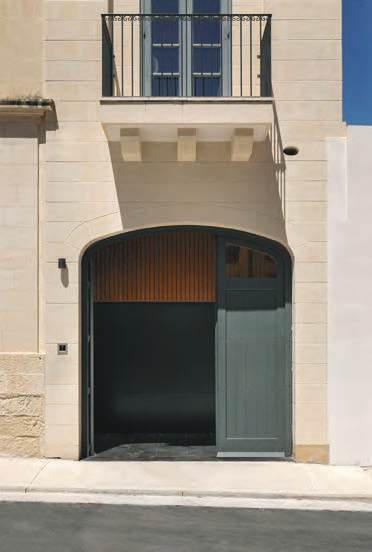
In Lembut, CVC has delivered a home that responds to the challenges of its site with intelligence and restraint. The architectural language remains grounded in minimalism, but it's layered with personal meaning – from the framed citrus tree to the elevated car gallery. It is a house that not only fits comfortably within its traditional surroundings, but quietly redefines what it means to live with – and around – one’s passions.
ARCHITECTURE:
CVC Architecture Studio.
PROJECT TEAM: Andrea Vassallo Cesareo, Ian Critien, Samuel Cremona, Gabriel Micallef, Bianca Darmanin, Chiara Darmanin.
GARAGE DOOR, CUSTOM UNITS AND WOOD CLADDING: Custom Workshop Malta.
KITCHEN PENDANT: GLOW Lighting Design.
This page: A traditional remissa-style doorway preserves a visual continuity with the surrounding streetscape, while concealing the layered composition within. Behind this entryway, a series of materials –teak veneer on plywood cladding, and dark custom-designed doors crafted in aluminium composite for the entry and garage supplied by CUSTOM WORKSHOP MALTA –begin to hint at the refined modernism that unfolds inside.

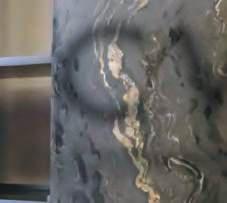
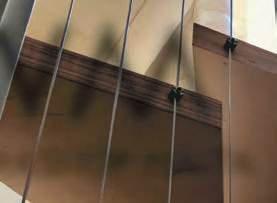



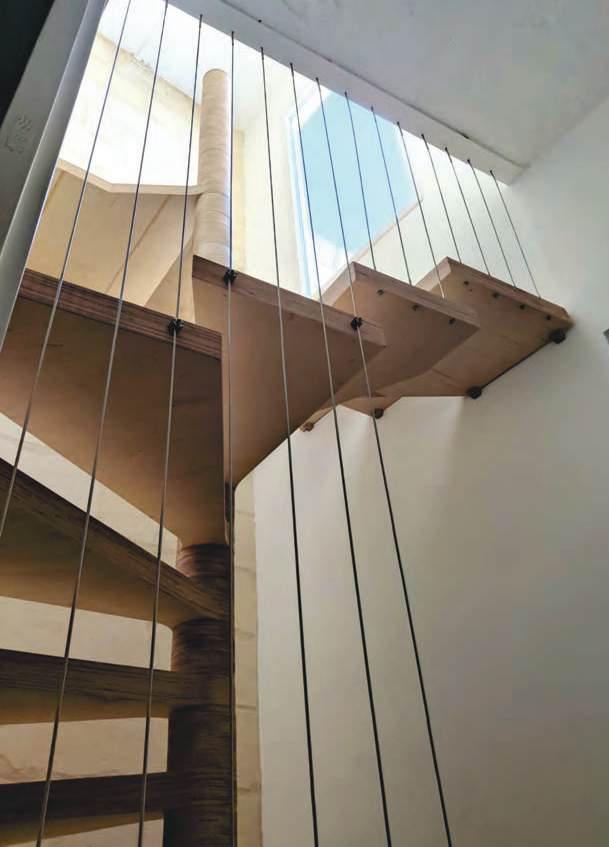

At our workshop, we help our customers bring their ideas to life. We strive to create products that will last –choosing quality materials is key, and so is workmanship. We cater for large and small projects, and various types of customised furniture can be manufactured, with unique designs and patterns, cut with our CNC machine for accuracy and an exact crisp finish.






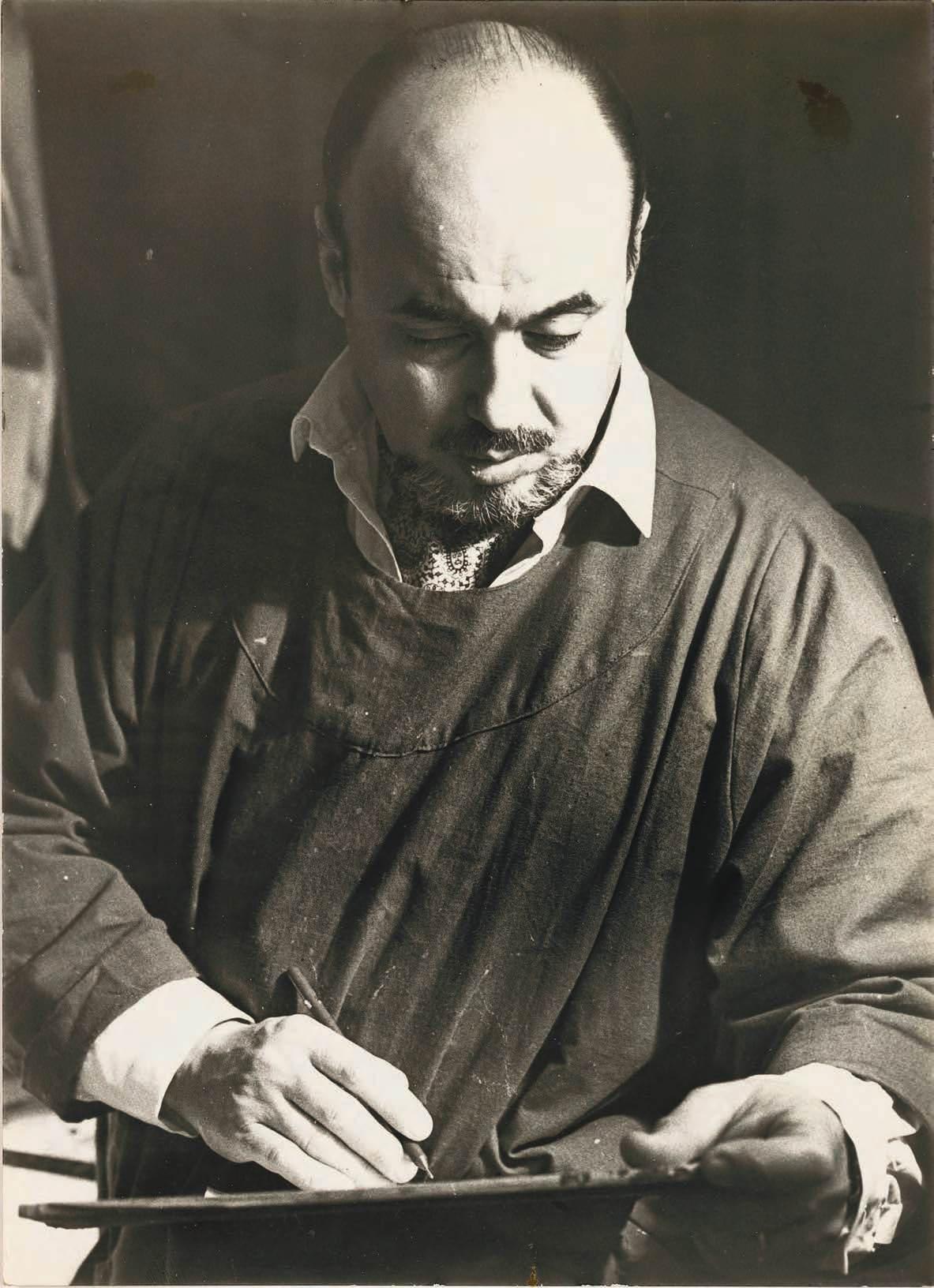
THE VICTOR PASMORE GALLERY

A modernist master who defied convention, Emvin Cremona transformed Malta’s visual language in the post-Independence era. From striking church murals to bold postage stamp designs, his work bridged tradition and abstraction with fearless innovation. Emvin Cremona – The Glass Collage, an exhibition running until 12th July 2025 at the Victor Pasmore Gallery revisits the life, influences and legacy of an artist who contributed to the cultural identity of twentieth-century Malta.
Photography courtesy Fondazzjoni Patrimonju Malti.


There is a rare tension in the art of Emvin Cremona(1919-1987) that both unsettles and enthrals. From the sweeping mosaics of Ta‘ Pinu to his smallest stamp designs, his work holds an enduring fascination. Now, Emvin Cremona – The Glass Collage, an exhibition running until 12th July 2025 at the Victor Pasmore Gallery in Valletta, draws attention to one of his most enigmatic bodies of work. Often referred to informally as the ‘broken glass series’, Cremona himself called them ‘glass collages’ – a distinction that signals intention, not accident. These are not
fragments simply shattered and left raw, but materials reassembled into a deliberate visual language that plays with rupture and repair, violence and beauty, fragility and resilience.
The exhibition, organised by Fondazzjoni Patrimonju Malti, brings together these works in an attempt to explore Cremona’s process and the broader context in which they were created. There is a strong sense of material consciousness in these collages, in keeping with Cremona’s lifelong interest in the physical and tactile possibilities of artmaking. Glass, with its simultaneous transparency and danger, becomes the perfect medium through which to explore the creative act itself –creation, destruction and reinvention playing
out on each reconstructed plane.
This show is also the first in a series dedicated to modern Maltese artists who worked during or alongside Victor Pasmore’s own artistic trajectory. It seeks to provide not only a platform but also a re-evaluation of their contribution to the visual culture of Malta in the twentieth century. Many, including Cremona, remain better known for individual commissions than for their more experimental or conceptual practice. These glass works allow for a fresh reading of Cremona as an artist who, even when fulfilling ecclesiastical or state functions, was driven by a private, restless search for meaning in material.


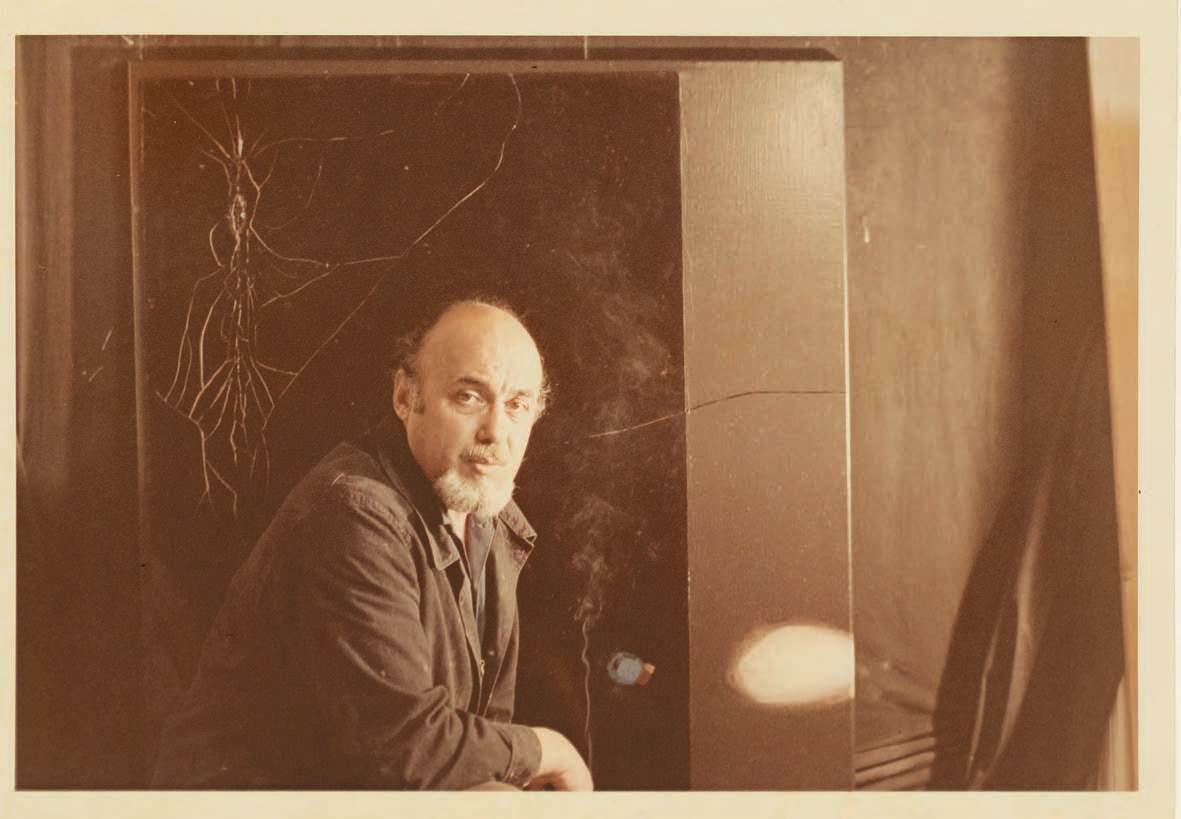
Born in Valletta in 1919, Emanuel Vincent Cremona showed early artistic talent, despite little encouragement from his family. He began his formal training at the Malta Government School of
Art, later continuing his studies in Italy during a period of political upheaval. Like many Maltese students of the time, he navigated the ideological tensions of Fascist Rome in order to pursue his education, forging close relationships with contemporaries such as Anton Inglott. The two returned to Malta on the last boat
before war broke out, and Cremona spent the following years contributing his skills to camouflage design and restoration work with the Royal Engineers. His wartime experience helped embed a sense of purpose in his work, which remained engaged with national identity even as it explored more avant-garde styles.

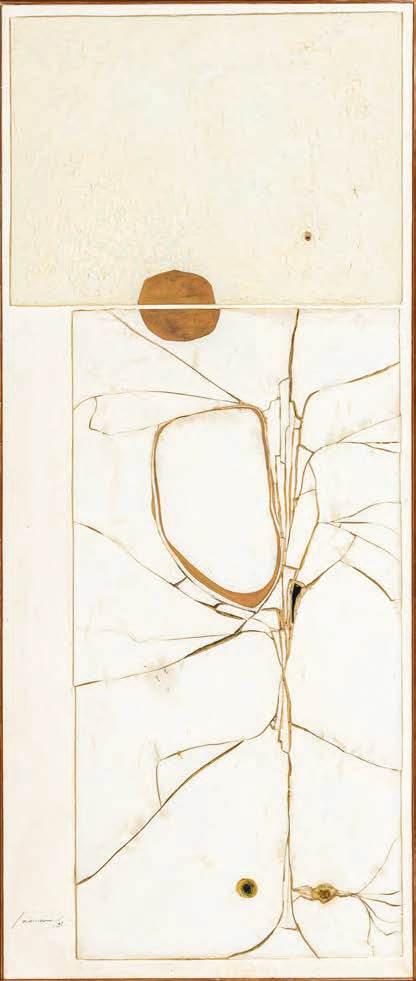
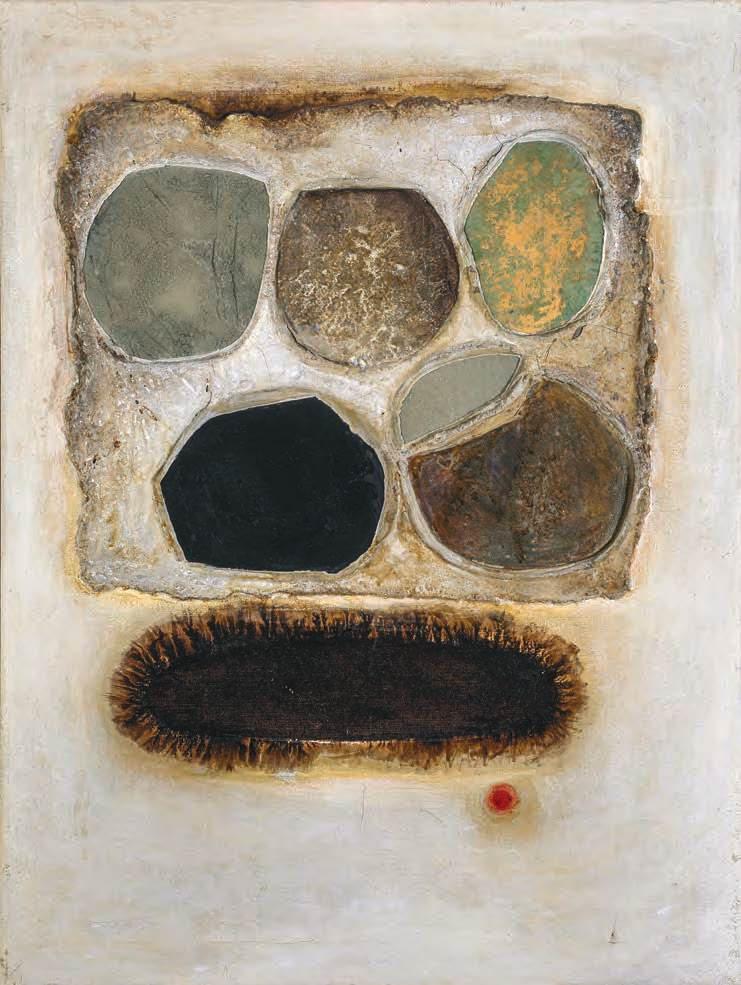

His later studies in London and Paris further exposed him to international developments, with hints of Tachisme and the influence of Jean Fautrier occasionally surfacing in his paintings. But it was his work in Malta – most visibly on churches, public buildings and postage stamps – that truly defined his public output. Bold colour, geometric rhythm and stylised figures became hallmarks of his aesthetic, balancing modernist abstraction with the symbolic language of religious art. These projects – such as the altar at Nadur or his contribution to the Ħamrun parish church – were both spiritual and architectural in ambition, merging the contemporary with the sacred. Yet the glass collages stand apart. They seem to bypass iconography altogether in favour of texture, fragmentation and the physical act of reassembly. They speak of a quieter, more introspective artist, working not for commission but for compulsion. The surfaces shimmer with discomfort as
much as light, creating patterns that resist full resolution. In a world fractured by war, displacement and ideological conflict, Cremona’s collages offer no simple answers, only the integrity of materials consciously rearranged.
Emvin Cremona – The Glass Collage invites viewers to reflect not only on one artist’s vision but also on the process of rebuilding – of history, identity, and form. It is an evocative start to what promises to be a vital series at the Victor Pasmore Gallery, offering space for contemplation and reappraisal. The collages, like Cremona himself, remain singular and quietly defiant, formed from shards and yet wholly composed.
EMVIN CREMONA – THE GLASS COLLAGE, until 12th July 2025, at The Victor Pasmore Gallery, APS House, 275 St Paul Street, Valletta. Open Tuesdays to Thursdays 10am-5pm (last entry 4pm), Fridays 10am-7pm (last entry 6pm), Saturdays and Sundays 10am-3pm (last entry 2pm). Tickets can be purchased at the door.





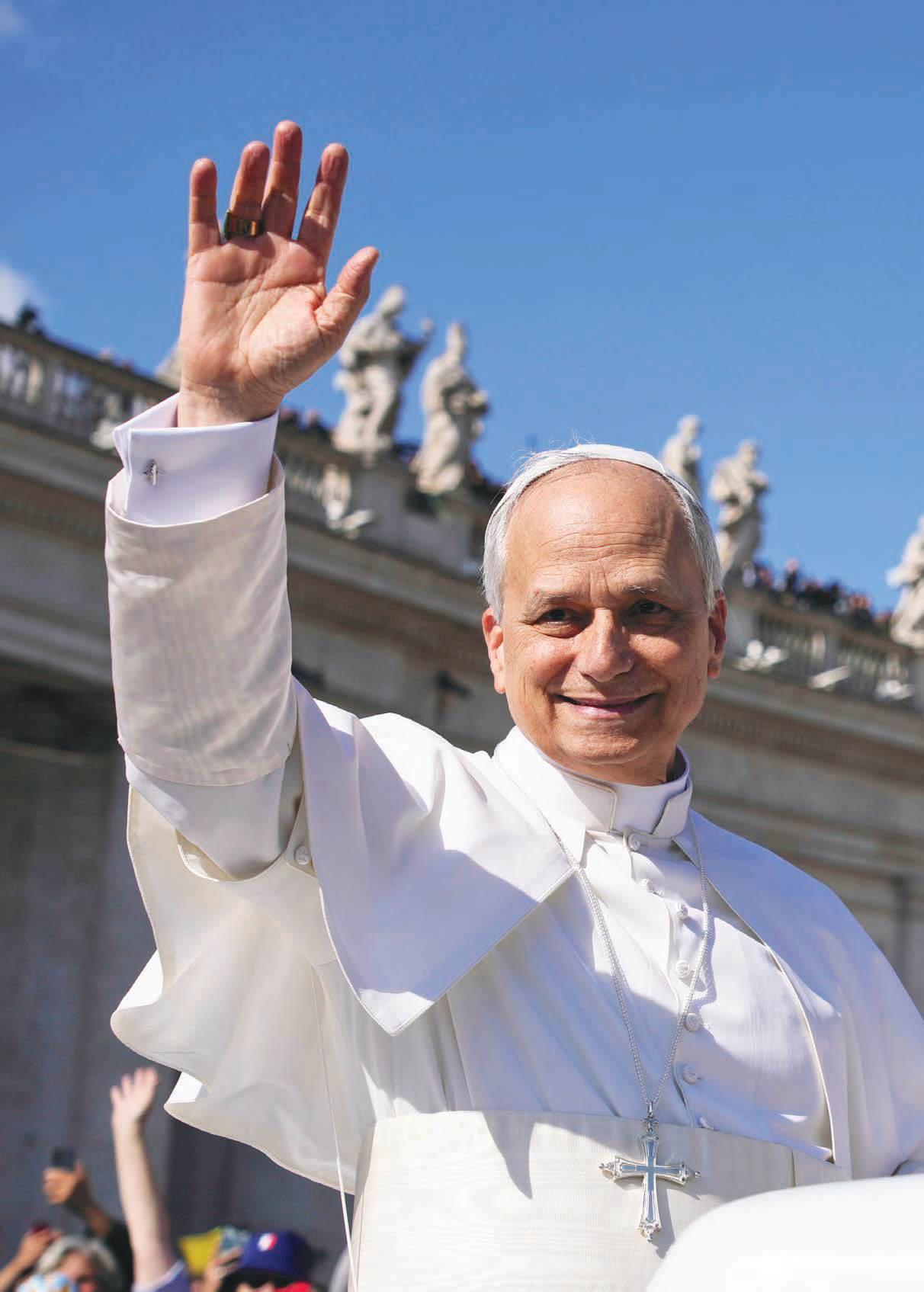


“Peace be with you all!”
A quiet man of intellect and conviction, Pope Leo XIV brings a lifetime of missionary work, academic rigour and pastoral care to the world’s most visible pulpit. From Chicago to the streets of Trujillo, this is a pontificate rooted in humility, shaped by global experience, and carried by an urgent call to peace.

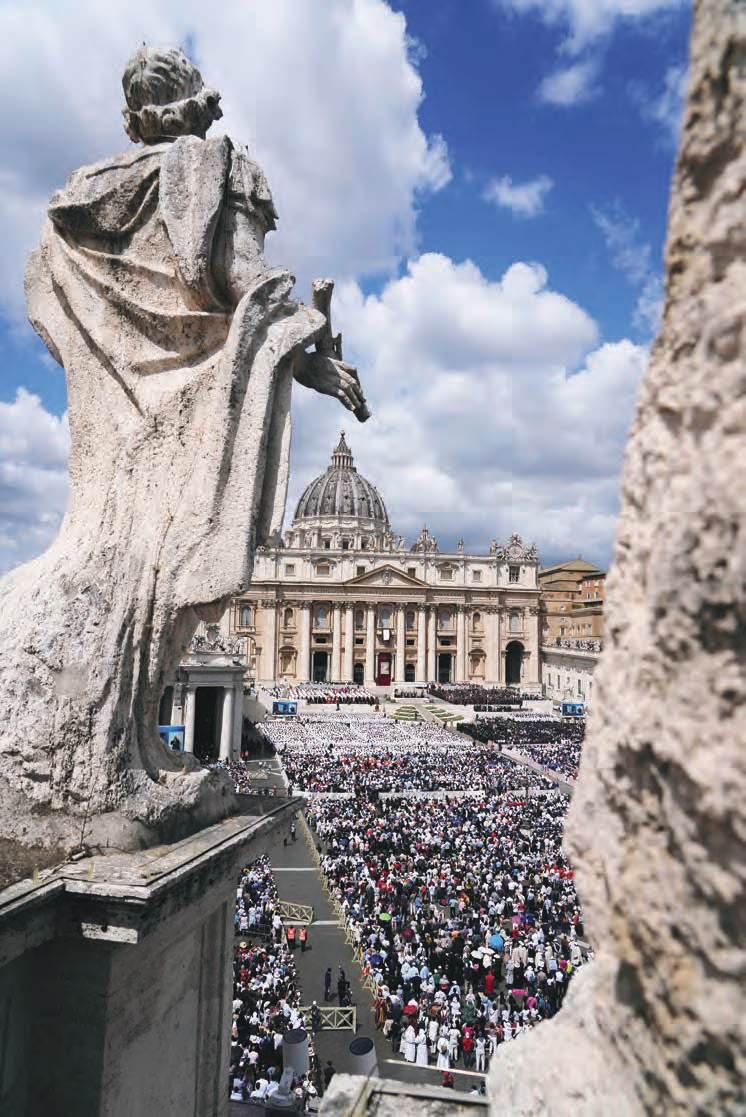
When Cardinal Dominique Mamberti stepped out onto the balcony of St Peter’s Basilica to proclaim Habemus Papam, a hush fell over the crowds below. Within seconds, the name of the new pontiff–Robert Francis Prevost– rippled across St Peter’s Square, turning that hush into a jubilant roar. Emerging moments, serene and softly smiling, Pope Leo XIV raised a gentle hand and offered his first words: “Peace be with you all.” A salutation to the sea of faithful gathered before him, and also to a fractured world in need of calm. The man now known as Leo XIV brings
with him a rich past shaped by decades of pastoral work, deep-rooted scholarship, and an authentic connection to the everyday. Born in Chicago in 1955 to a French-Italian father and a Spanish-American mother, he is the first Augustinian to occupy the Chair of Peter and only the second pope from the Americas. Before Rome, before red cassocks and conclaves, Robert Prevost was a committed missionary in Peru.
He arrived in Trujillo in the late 1980s, where modest parishes became the terrain of his ministry. He served not just as a teacher of Canon Law and Moral Theology but as parish priest, judicial vicar, and later bishop, often seen walking through the streets in sandals, sleeves rolled up, speaking to vendors and blessing children. There was no ivory tower to retreat to– only community. In the words of one parishionershared across Peruvian news, “Él nos conocía por nombre, nos escuchaba, y nunca se olvidaba de volver” – he knew us by name, he listened, and he always came back.
As Prior General of the Augustinian Order for two terms, Leo XIV cultivated a reputation for intellectual depth and administrative clarity. But even while based in Rome, he never quite let go of Peru. Messages from friends and former colleagues flooded social media after his election, many posting old photos of him in the hills of Chiclayo or carrying a statue of Saint Rita through narrow village streets. Their joy was unmistakable. For them, he is not a distant figure. He is their Padre Roberto,the priest who fixed broken doors and offered confession beneath mango trees.
Even in Rome, he remained very down-toearth. The Omega gym in Rome has long been frequented by residents of Prati, as well as priests and nuns from the Vatican nearby, and also, the man who would become pope. Gymgoers were startled to find out that it was Cardinal Prevost on the treadmill– jogging at a slow but steady pace. “When the name of the pope was announced, my phone rings and my son tells me, ‘Dad, it’s Robert! Robert, our member!’” Francesco Tamburlani, the owner of the gym, said in an interview. “This moved us, filled us with joy.” “He used to come three times a week,” one trainer remarked to the Corriere della Sera, “quiet, friendly, always with a smile, never flaunting who he was. I don’t think I’ve ever heard him make a comment about anything that wasn’t positive. He was always positive about everything – the weather, the city, the people, also for me, he said he liked the gym.” That ordinariness–rooted, approachable, unvarnished– is part of what has made his election feel at once surprising and reassuring.
The process that led to his elevation is ancient, ceremonial, and laced with symbolism. Following Pope Francis’s death, the College of Cardinals gathered in conclave, the Sistine Chapel’s doors sealed behind them. Under Michelangelo’s painted ceiling, votes were cast until the required two-thirds majority was reached. Then came the moment the world watches for: white smoke rising from the chimney, a single signal that consensus– and a new Pope– had emerged.






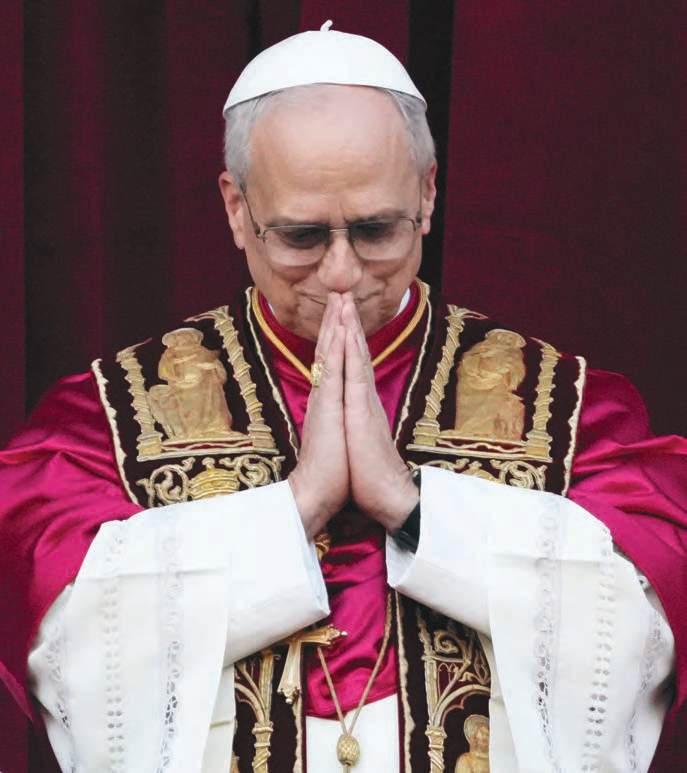
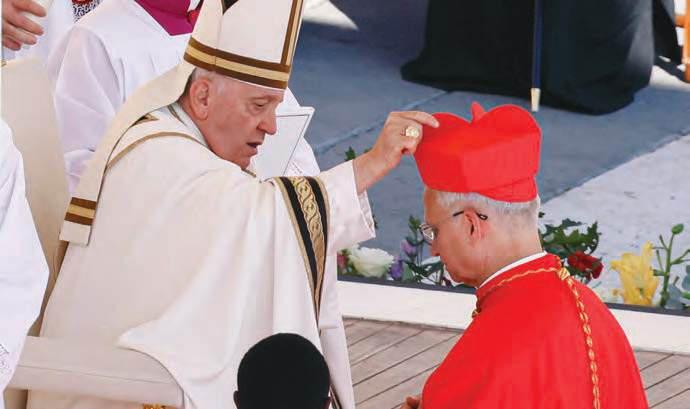


Newly elected Pope Leo XIV appears at the balcony
Thursday 8th May 2025. Photography Alessandra Tarantino / AP. Above: Pope Leo XIV, then Bishop Robert Prevost, venerates the image of the Lord of the Captive of Ayabaca during Mass in Motupe, Peru in 2018. Photo Julio Reano / AP. Centre: Newly elected Cardinal Robert Francis Prevost, Prefect of the Dicastery for Bishops, right, receives his biretta from Pope Francis as he is elevated in St. Peter’s Square at The Vatican, 30th September 2023. Photo Riccardo De Luca, AP File. Bottom: Pope Leo XIV, then Bishop Robert Prevost, gives a Mass in Motupe, Peru in 2018. Messages from friends and former colleagues in Peru flooded social media after his election. For them, he is not a distant figure. He is their Padre Roberto, the priest who fixed broken doors and offered confession beneath mango trees. Photo Julio Reano / AP.
At his Inauguration Mass in Saint Peter’s Square, attended by over 200,000 people and dignitaries from different faiths and continents, Pope Leo XIV spoke of unity and love in a tone that was direct and meditative. “Let us walk together along the path of God’s love and remain united in one family.”He acknowledged the disorientation that had followed the passing of his predecessor, Pope Francis. “We felt like sheep without a shepherd,”he said, “yet having received his final blessing on Easter Sunday... we remembered how the Lord never abandons His people.”
During the General Audience that followed, he asked for prayers not just for himself but for those “who feel forgotten or cast aside by the world.”Echoing the ethos of Saint Augustine, whose teachings he has long followed, Leo XIV’s episcopal motto remains In Illo uno unum – in the One, we are one.
The announcement of his papacy has not only been met with celebration across Latin America and the United States but has also struck a warm chord in Malta. As Cardinal, he visited the islands several times, fostering ties with the local Church and participating in regional ecclesial events.



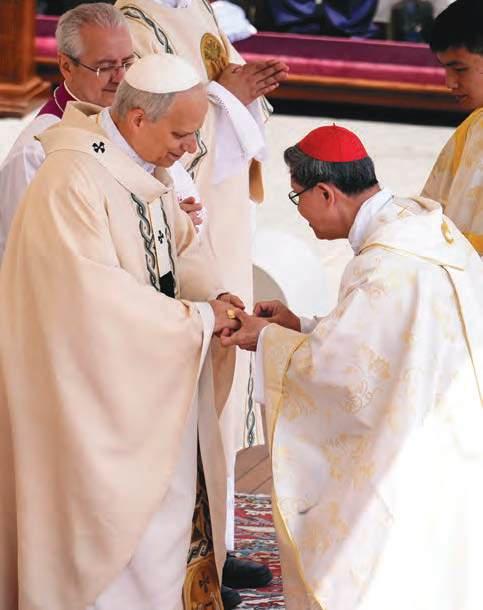
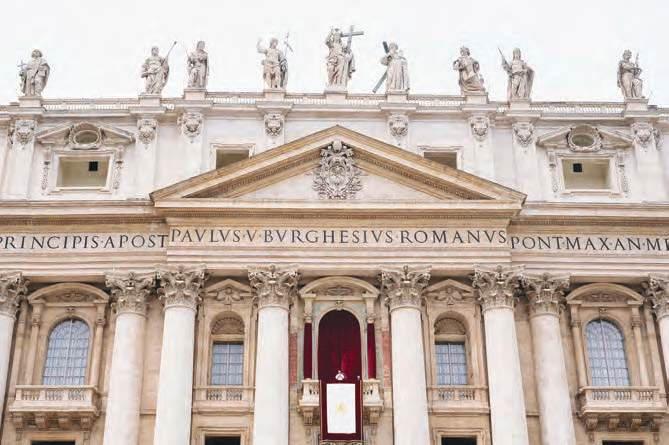
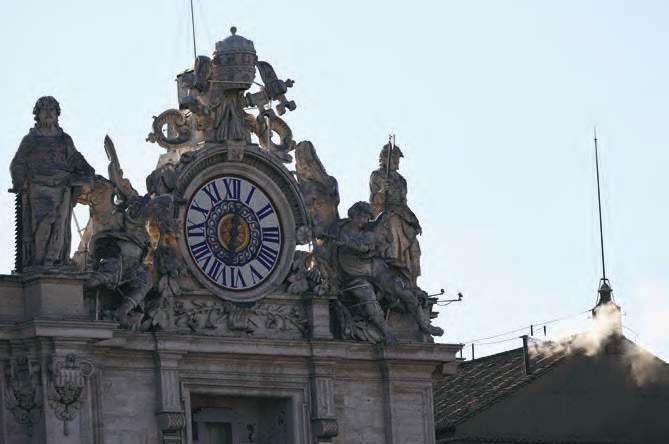
Though his schedule will now swellwith state visits and audiences,glimpses of his personal character continue to filter through. He is said to still rise early, to write longhand, and to walk through the Vatican Gardens when he can. His two brothers, Louis Martin and John Joseph, were present for his Inauguration Mass. “I’m almost speechless. It’s just mind-blowing that my brother was elected pope today,” Louis Martin Prevost told NBC News. According to Louis Martin, he and John Joseph used to tease their brother about becoming pope one day when he was a child, saying “he always had that holy way about him.”
Few roles on Earth carry the gravity of the papacy, but Pope Leo XIV appears to carry it aware of its burdenand guided by attentiveness. “I was chosen, without any merit of my own,” he said in his first address, “and now, with fear and trembling, I come to you as a brother, who desires to be the servant of your faith.”
Already, his approach suggests a continuation of the simplicity and spiritual openness that defined Pope Francis’s tenure. But with a distinctive voice shaped by both North and South America, by academic corridors and remote villages, by liturgy and daily bread, Leo XIV arrives as his own man–quietly resolute, spiritually sincere, and vividly human.In the face of a world marked by so much discord and wounds caused by hatred, violence, prejudice, fear, and economic reality “that exploits the Earth’s resources and marginalises the poorest, we want to be a small leaven of unity, communion, and fraternity within the world,” said the Pope at the Mass of Inauguration of his Petrine Ministry.
“Together, as one people, as brothers and sisters, let us walk towards God and love one another.”
As the bells of St Peter’s rang out and the crowds dispersed that first evening, the word that lingered in the air was the very one with which he began: peace.


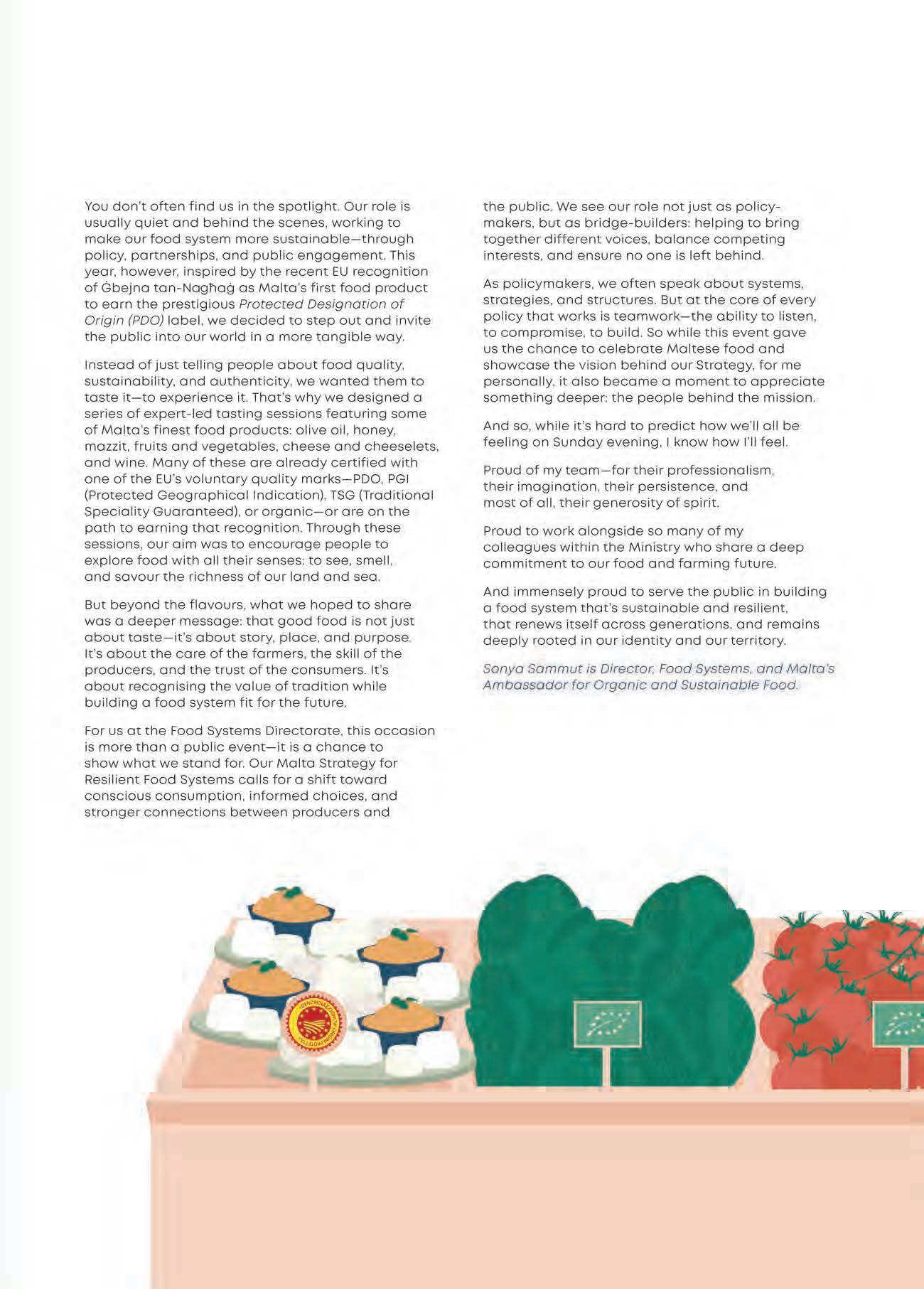
In July 2013, Pope Francis’s “If a person is gay and seeks God and has good will, who am I to judge?” statement become one of his most famous statements on LGBTQ people. In other public statements, Francis emphasised the need to accept, welcome, and accompany LGBTQ people, including LGBTQ children, and denounced laws criminalising homosexuality. “If they accept the Lord and have goodwill, who am I to judge them? They shouldn’t be marginalized. The tendency (same-sex attraction) is not the problem... they’re our brothers.” On 19 April 2019, Francis appeared on the final episode of Pilgrimage: The Road to Rome, a three-episode miniseries broadcast on BBC Two. Meeting gay comedian Stephen K. Amos, Francis said: “Giving more importance to the adjective rather than the noun, this is not good. We are all human beings and have dignity. It does not matter who you are or how you live your life: you do not lose your dignity. There are people that prefer to select or discard people because of the adjective – these people don’t have a human heart”. In May 2024, Pope Francis spoke with 60 Minutes in an interview with Nora O’Donnell. O’Donnell quoted Francis saying “Homosexuality is not a crime” and Francis answered: “No. It is a human fact.”
HUMAN, FIRST
Observed in over 150 countries, the International Day Against Homophobia, Transphobia, and Biphobia –IDAHOBIT – calls for dignity, visibility, and safety for LGBTQIA+ people everywhere. In a world still marked by silence and stigma, Malta’s progress offers hope –and a reminder that equality must be lived, not only legislated.
Every year on 17 May, the International Day Against Homophobia, Transphobia, and Biphobia – IDAHOBIT– marks the date in 1990 when the World Health Organization removed homosexuality from its list of mental disorders. Thirty-five years on, the date serves as a moment of global reflection and solidarity– one that is still painfully necessary.
Across the world, over 60 countries continue to criminalise same-sex relationships, and many more enforce discriminatory laws or fail to offer basic protections to LGBTQIA+ individuals. In 2024, Uganda passed a law allowing for the death penalty in certain cases involving same-sex activity. In Russia, so-called ‘LGBT propaganda’laws have led to the shutting down of rights organisations and the silencing of public voices. In the United States, antitrans legislation continues to sweep through state legislatures, limiting access to healthcare, education, and even public toilets for transgender people. And across social media, hate speech, disinformation, and online harassment have spiked dramatically, further fuelling a climate of hostility.
The brutality may take different forms, from violence and imprisonment to social ostracism and mental health tolls. Yet the message is often the same: you do not belong. You are not safe.
In this context, IDAHOBIT has grown into a powerful, decentralised movement. It is recognised by the European Parliament, the United Nations, and hundreds of national and local governments. Today it is marked in 155 countries, including 35 where samesex relationships remain illegal. It provides a rare, unifying global platform for activists, NGOs, cultural institutions, and governments to speak in chorus–even when their contexts are vastly different.
One of the day’s greatest strengths is that it resists prescription. While the acronym may evolve– in some regions, intersexphobia and acephobia are included, or the term lesbophobia is added– the spirit remains the same: to raise visibility and push back against violence and discrimination in all forms. IDAHOBIT is not a brand; it is a banner under which diverse communities find common cause.
Here in Malta, it is easy to forget how far the country has come in such a short span. Once lagging behind on LGBTQ rights, Malta has become a global frontrunner, consistently ranking first on ILGAEurope’s Rainbow Map since 2016. Marriage equality, gender recognition based on self-identification, adoption rights, anti-discrimination protections in employment and healthcare– Malta’s legislative framework is now among the most progressive in the world.
Yet, legislation alone cannot always reach the intimate spaces where fear, prejudice, and shame take root. The experiences of LGBTQIA+ individuals in Malta are not monolithic. Religion, family, ethnicity, and class all complicate how safe someone may feel in their own skin. Trans and non-binary people, in particular, continue to face social stigma, misrepresentation, and marginalisation– even in societies where laws protect them. Visibility matters. Language matters. And so does listening.
That’s why cultural, artistic, and public events around IDAHOBIT are important. They are not just celebrations– they are opportunities to remind society that equality is not achieved just through policy, but through daily gestures of inclusion, through changing minds, through being willing to sit with discomfort. They offer space to listen to LGBTQIA+ voices in all their complexity: angry, joyful, weary, proud. And those voices include people of faith. While many religious institutions globally continue to promote exclusionary views, others are re-examining how their theology can coexist with dignity, equality, and welcome. Pope Francis was a singular figure in this conversation. Since his now-famous 2013 quote –“If a person is gay and seeks God and has good will, who am I to judge?” – he continued to call for compassion and inclusion.
In May 2024, in an interview with Nora O’Donnell on CBS’s 60 Minutes, Francis was clear once more–O’Donnell quoted Francis saying “Homosexuality is not a crime”and Francis answered: “No. It is a human fact.” It is a rare moment when someone in his position speaks so plainly, without euphemism or hedging.
On 19 April 2019, Francis appeared on the final episode of Pilgrimage: The Road to Rome, a threeepisode miniseries broadcast on BBC Two. His words from this episode offer a poignant close. “Giving more importance to the adjective rather than the noun, this is not good. We are all human beings and have dignity. It does not matter who you are or how you live your life: you do not lose your dignity. There are people that prefer to select or discard people because of the adjective – these people don’t have a human heart”.

Wirja
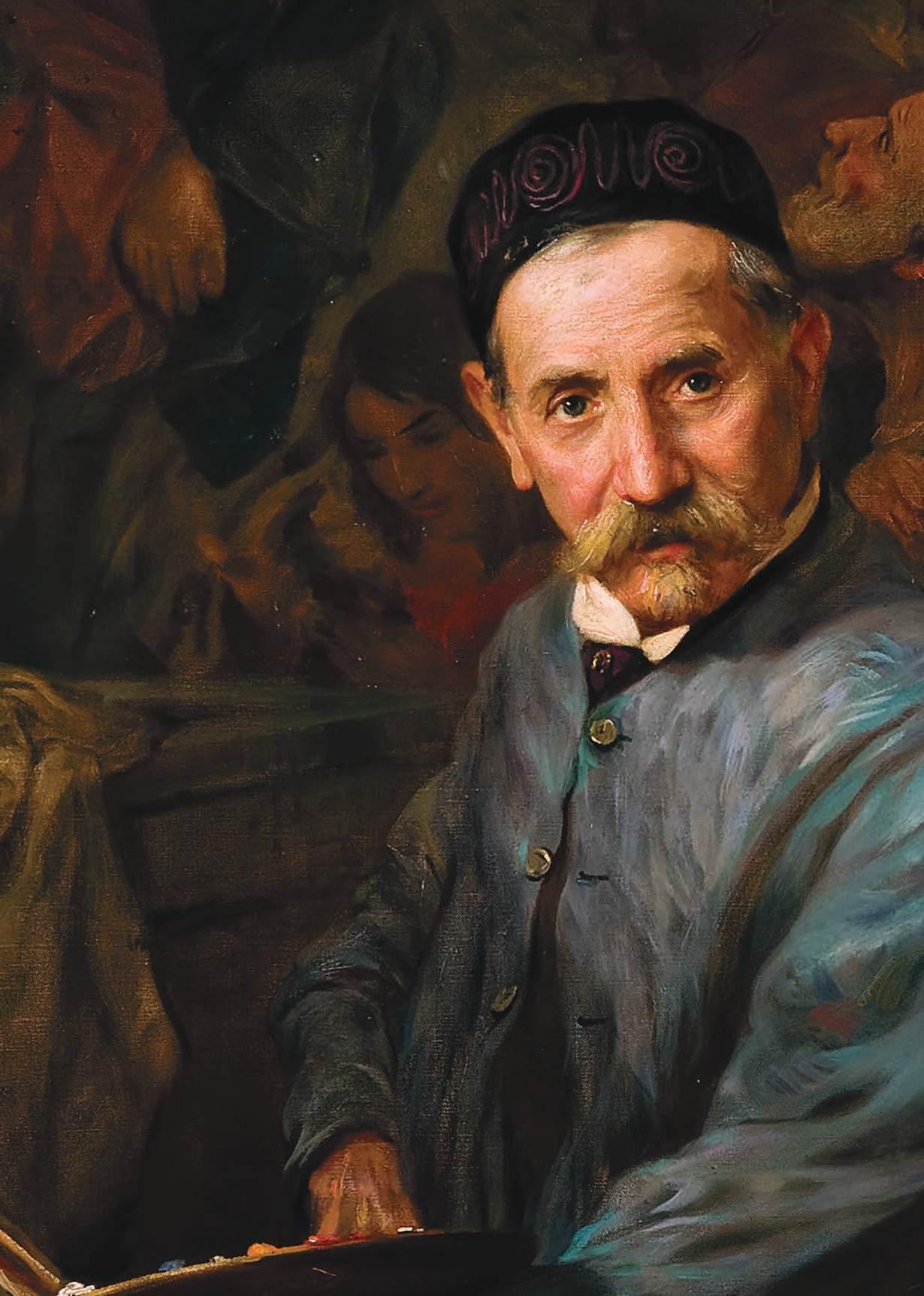
niċċelebraw lil
22 ta’ Mejju - 4 ta’ Ġunju
Fil-Knisja ta’ San Duminku, il-Belt Valletta


1975-2025
MALTA REMEMBERS: 50 YEARS OF STORIES, 80 YEARS OF PEACE
Marking half a century since a small group of volunteers first opened the National War Museum at Fort St Elmo, Heritage Malta invites the public to two special events honouring the legacy of wartime resilience and peace. A concert and open day will bring history to life, from live jazz to re-enactments, rare artefacts, and a dramatic vintage flypast.
Photography courtesy Heritage Malta.
What is now one of Malta’s most popular museums – the National War Museum –started as a modest exhibition in lower Fort St Elmo in Valletta, set up in 1975 by a group of volunteers who called themselves The National War Museum Association.
In honour of the enduring spirit of these passionate individuals who laid the foundations for today’s museum, and the 80th year since guns went silent in Europe at the end of WWII, Heritage Malta and the National Celebrations Foundation are inviting the public to two special events.
On Friday 30th May, As One – A Concert for Peace, will pay tribute to wartime resilience whilst calling for unity and peace. The concert opens with WWII Impressions, a jazz suite composed by Dominic Galea and inspired by the war-era musical Il-Gwerra ta’ Spiru Cefai, followed by a selection of popular anti-war songs headlined by Ivan Grech. Stripped-back acoustic arrangements, evocative visuals, and a live choir will create a stirring atmosphere of remembrance and solidarity.
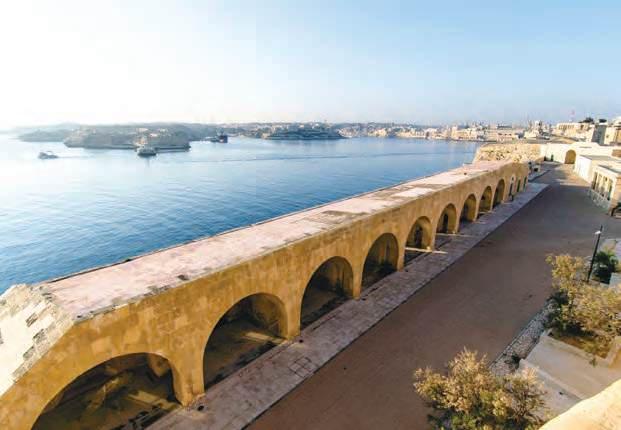

all the coastal fortifications entrusted with the defence
to the public in 2023.

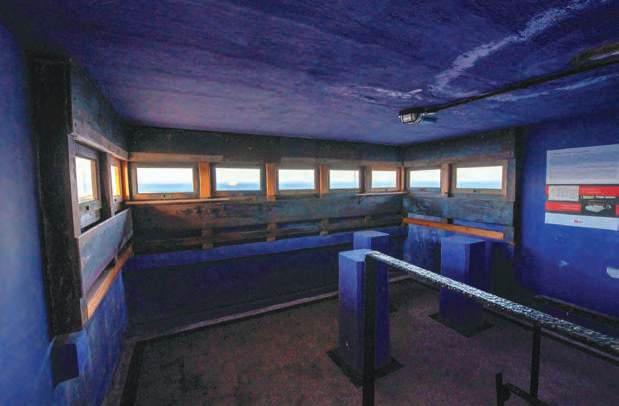
On Sunday 1st June, an open day for all the family invites the public to explore Fort St Elmo and the National War Museum. The museum will offer guided tours alternating in Maltese and English every hour from 10:00 to 17:00. Visitors will also be able to view the George Cross alongside the original letter from King George VI, specially loaned for the occasion by the National Library of Malta. Talented re-enactors will bring history to life throughout the day, complemented by a variety of activities curated by Heritage Malta’s Underwater Cultural Heritage Unit (UCHU), Diagnostic Science Laboratories (DSL), and Education Department.
A new immersive installation by Heritage Malta’s Technology and Experience Development (TED) Unit will highlight the pivotal role of the Bofors Light Anti-Aircraft gun. Weather permitting, a vintage Piper J-3 Cub will fly over the skies above Fort St Elmo –a thrilling highlight not to be missed.
Three new war-related Heritage Malta publications will be available – one marking the 50-year milestone of the museum by spotlighting 50 unique artefacts from its collection, another explaining the Second World War in a more engaging format for younger audiences, and the third focusing on the awarding of the George Cross –featuring fresh curatorial research.
Free tickets for the concert on the 30th May can be booked online on heritagemalta.mt/store/e1728 or at any of Heritage Malta’s museums and sites. Availability is on a first come, first served basis. For more information visit: heritagemalta.mt/whats-on/celebrating-50-years-of-thenational-war-museum-1975-2025-open-day


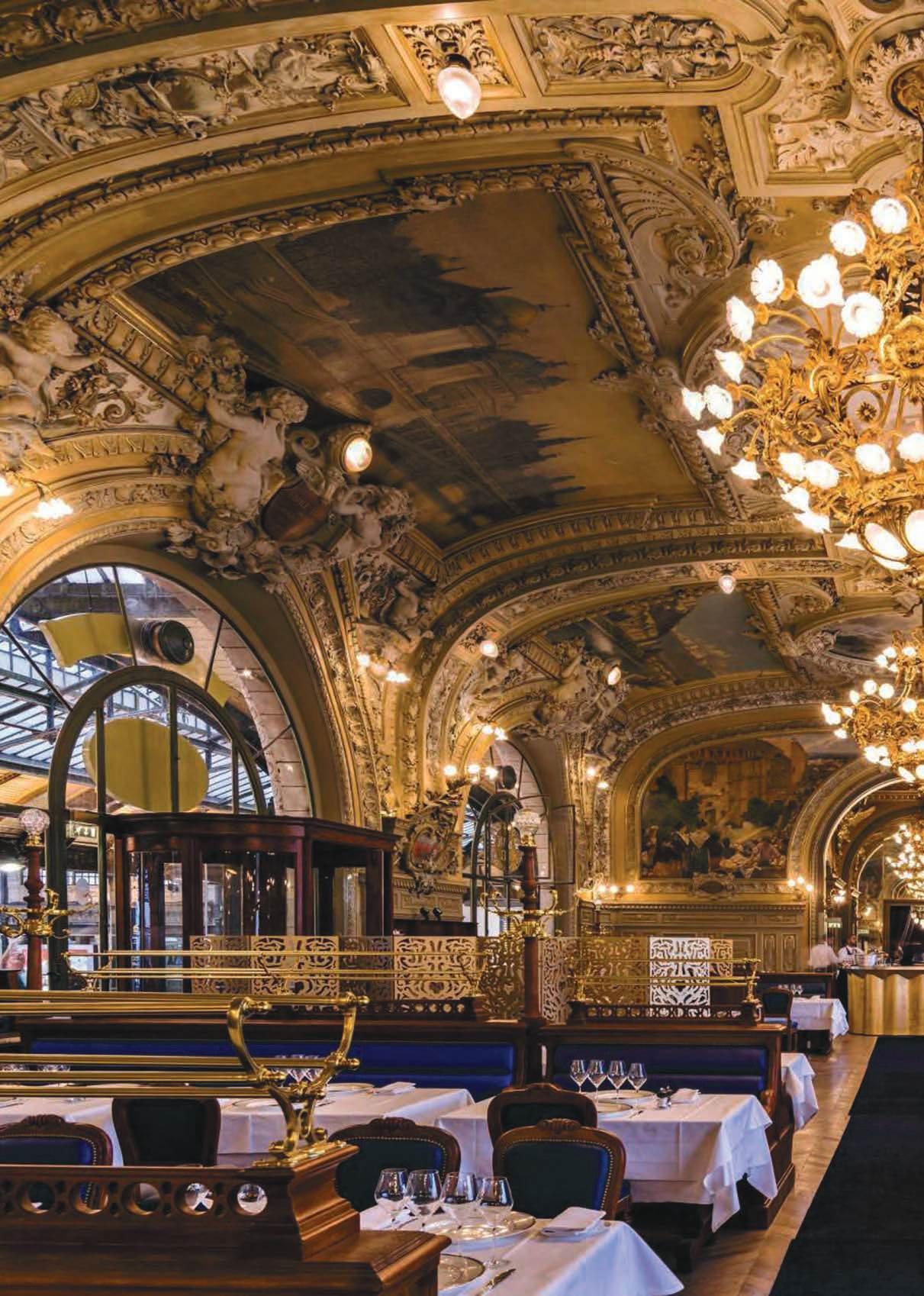
“Paris is always a good idea.”
Audrey Hepburn

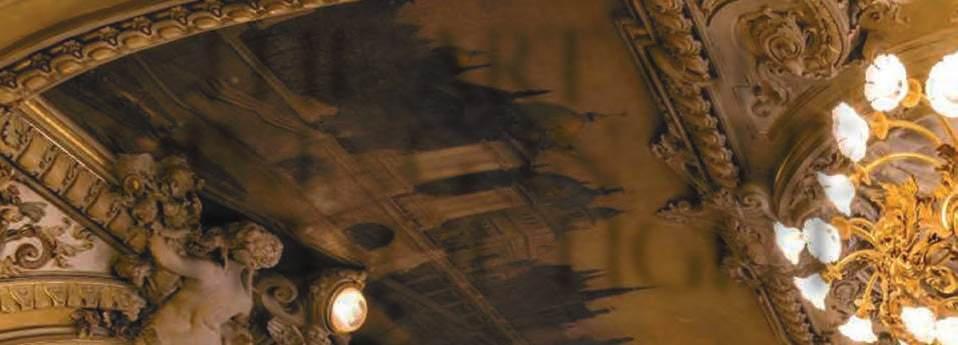
While other cities often chase reinvention, Paris has long understood the pleasure of permanence. Its boulevards may change with the seasons, and its kitchens may embrace the occasional reinvention, but the soul of Parisian dining is anchored in places that have survived centuries, because the experience they offer is entirely irresistible.

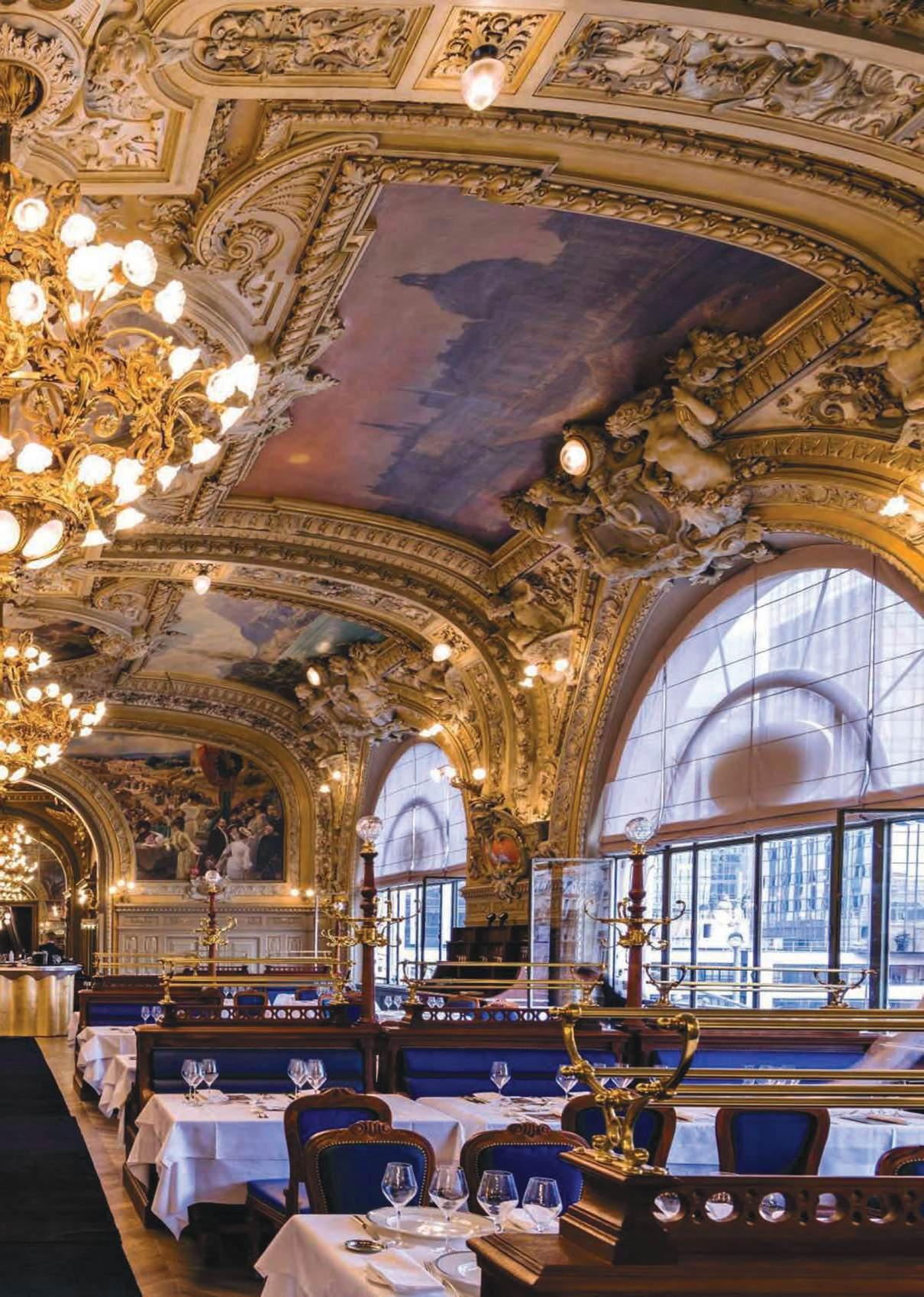
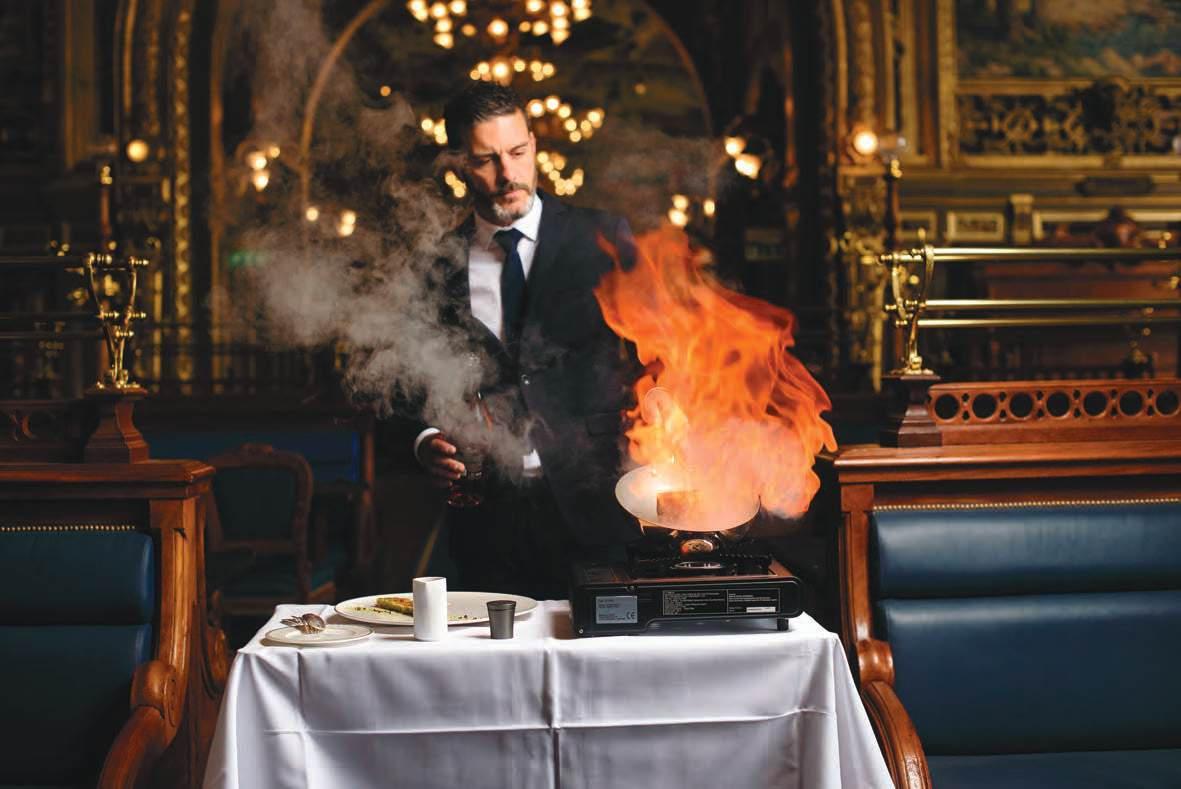
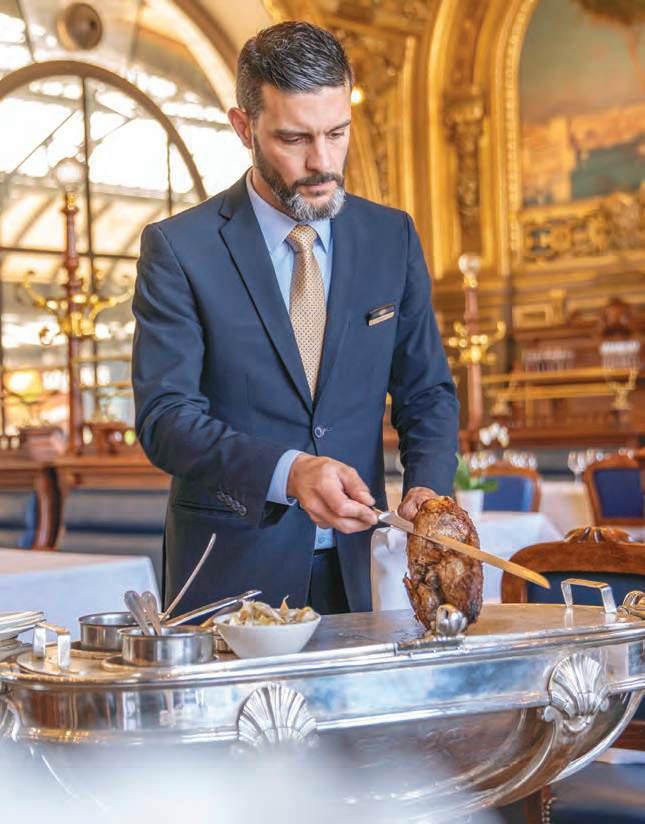
To eat in one of Paris’s grand historic restaurants is to participate in something close to ritual. These are not merely places that chase Michelin dreams and serve food –they are rooms with memory, charged with the presence of those who have dined there before: artists, diplomats, dreamers, and seducers – from before the French Revolution through to the jazz age and today. That so many of these restaurants remain open, vibrant, and even Michelin-starred today, says as much about the Parisian reverence for tradition as it does about the enduring appeal of truly theatrical hospitality.
Le Train Bleu at Gare de Lyon brings the theatre of travel into the equation. Designed for the 1900 Exposition Universelle and once the dining stop of well-heeled travellers heading south, it remains one of the city’s most cinematic dining experiences. Gilded ceilings, oil paintings, velvet upholstery and luminous chandeliers lend it the air of a museum, but the cuisine is resolutely alive: entrecôte, quenelles, and seasonal tarte Tatin are served with flair, and the hum of conversation under the vaulted arches creates a kind of operatic energy. There is something slightly surreal about stepping off the platform and into a dining room that could belong to the Louvre – and that, of course, is the point.
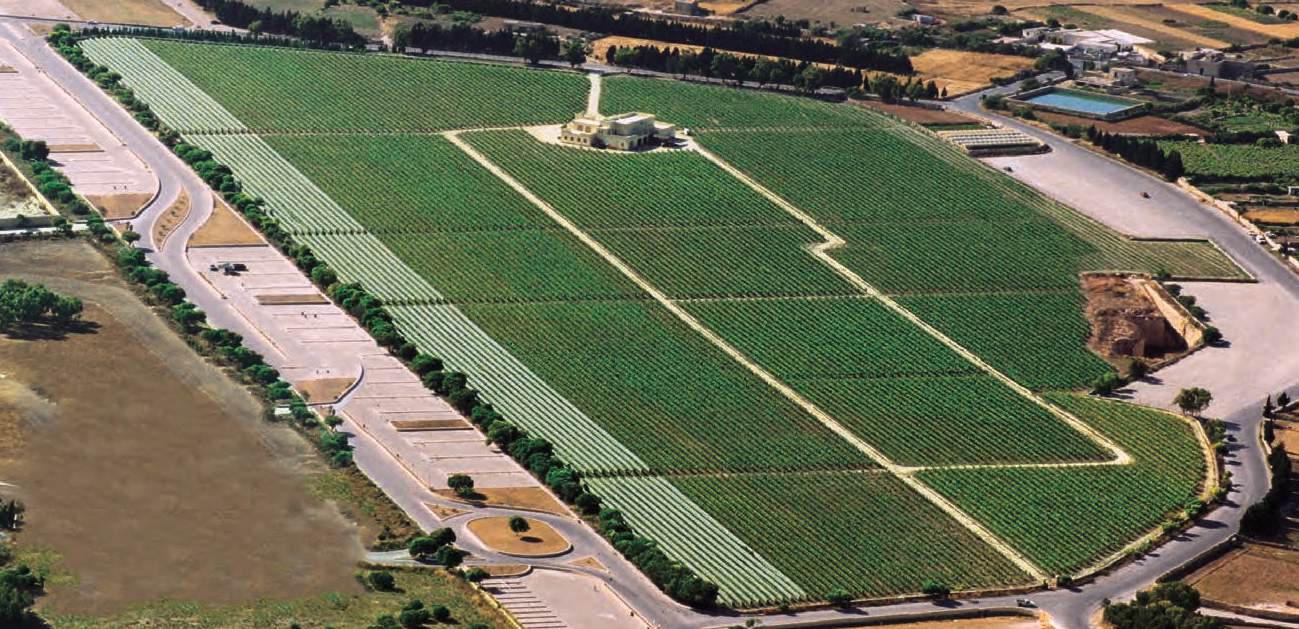









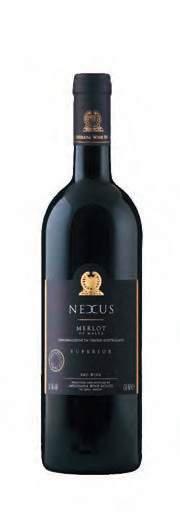


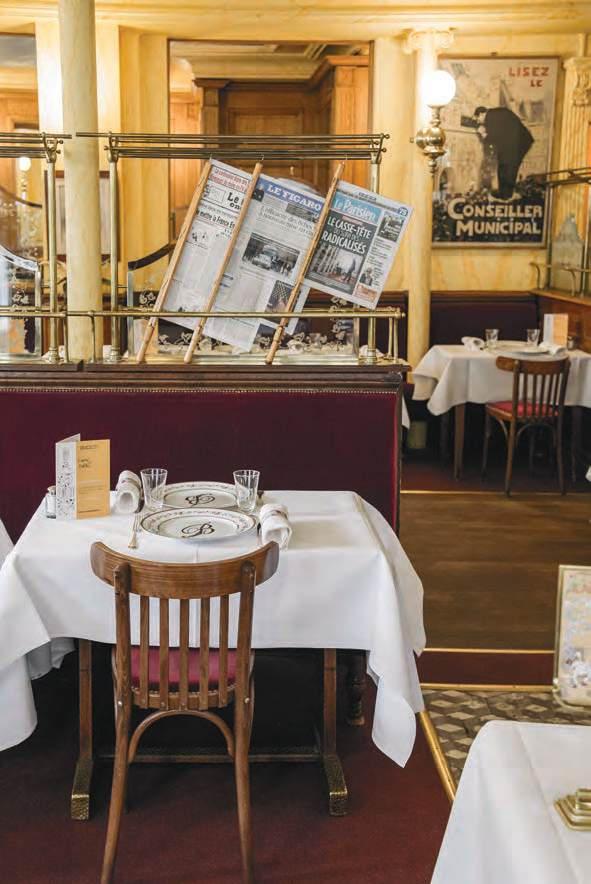
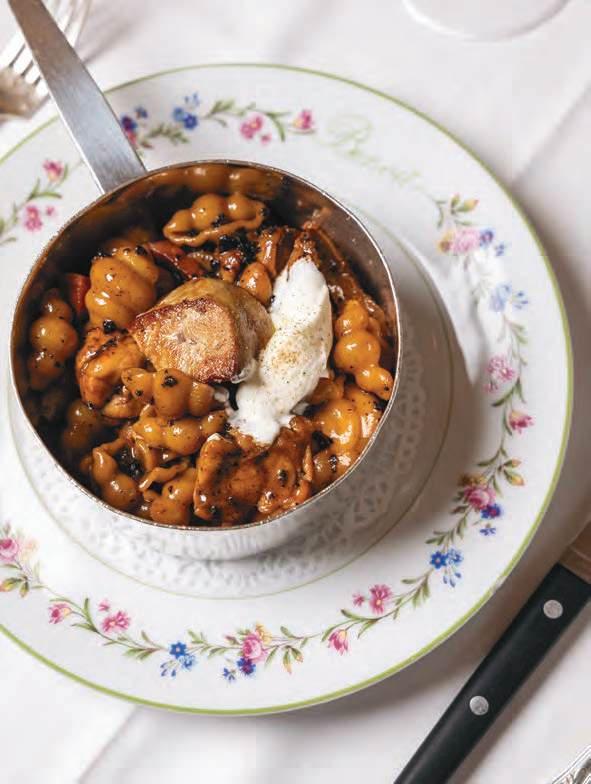

This page: BENOIT. Photography courtesy Benoit Paris.
Above left: Benoit is one of those “places of memory... adorned with mirrors, stained glass, stucco, glazed tiles, and wood panelling; they are authentic living spaces where escargots, cassoulet, or profiteroles take centre stage in a spirit of genuine conviviality,” says Alain Ducasse. Photo Pierre Monetta.
Above right: Armagnac savarin with lightly whipped cream.
Photo Pierre Monetta. Left: Gourmet casserole of veal sweetbreads, cockscomb, kidneys of cockerel, foie gras, truffled jus.
Photo Bertille Chabrolle.
Across the city lives Benoit, a charming corner bistro opened in 1912, which Alain Ducasse has subtly revived without ever disturbing its spirit. White tablecloths, tiled floors, wood-panelled walls, and mirrored interiors cocoon diners in an atmosphere that feels both entirely of the past – as if you are seated in one of Édouard Manet’s paintings – and absolutely current. There is onion soup, bubbling and rich, a confit de canard that arrives with the appropriate crispness, and a millefeuille that collapses on the fork in exactly the right way. The rhythm of the service is relaxed but precise, and the warmth of the room encourages conversation to linger. It’s about allowing the art of dining to unfold at its own proper pace.Ducasse, who has always understood the deeper purpose of gastronomy, once said: “Cooking is a love story. You have to fall in love with the products and then with the people who cook them.” At Benoit, the sentiment is tangible.





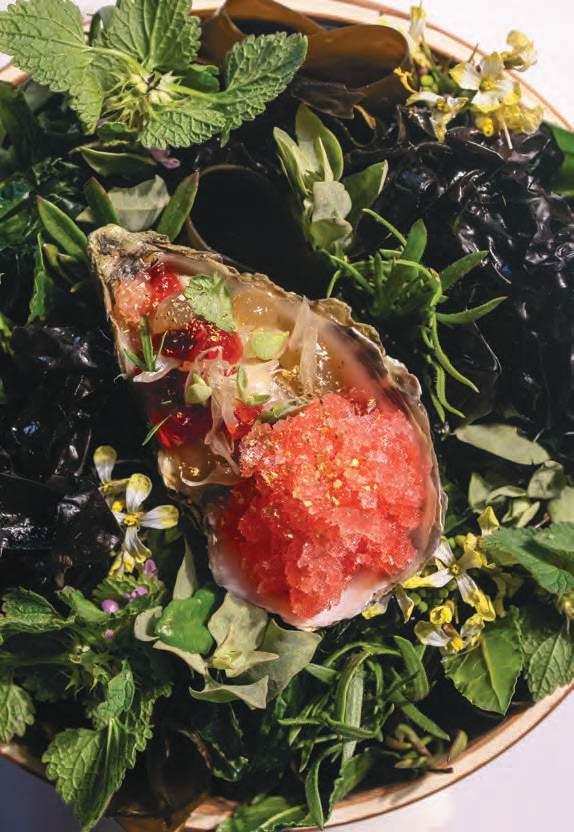
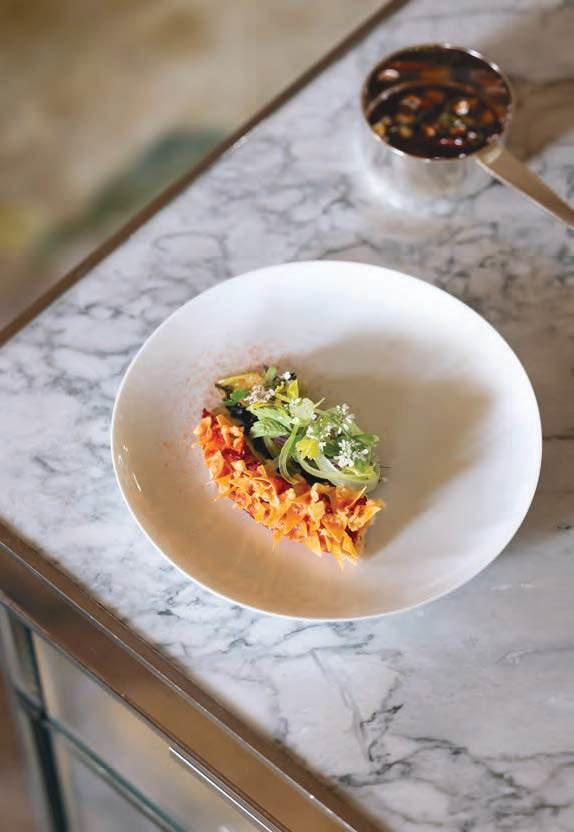
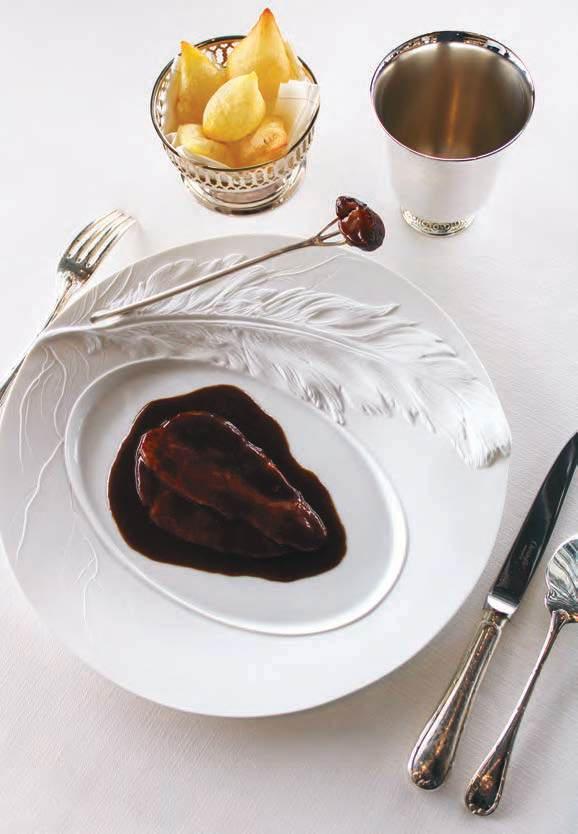
Where Benoit draws you in, Le Meurice Alain Ducasse presents a different kind of spectacle – Versailles-like drama. Inside the palace-like Meurice hotel, across from the Tuileries Garden, diners are ushered into a world of antique mirrors, marble, and gold leaf. It would be easy for such grandeur to feel stiff, but Ducasse’s vision avoids pastiche. The dishes – often vegetable-led, elegantly restrained, with a whisper of the Mediterranean – are
Facing page: LE MEURICE. Photography courtesy Le Meurice, Paris. Top left: Inspired by the Salon de la Paix in the Chateau de Versailles, Restaurant Le Meurice by Alain Ducasse is magnificent – all antique mirrors, crystal chandeliers, bronzes, marbles and frescoes. PhotoLe Meurice, Paris.
Far Left: Explosion of colours and textures... Oyster La Laurene x Blood Orange x Negroni, an unparalleled gastronomic experience. Photo Maki Manoukian. Left: Crispy blue lobster / celery / clove / marrow / lovage, a refined dish that celebrates the flavour of the king of shellfish. Photo Maki Manoukian. This page: LA TOUR D’ARGENT. Photography courtesy La Tour d’Argent Paris.
Top left and right: First devised by 19th-century owner Frédéric Delair, La Tour d’Argent’s famous pressed duck endures to this day, complete with its elaborate tableside presentation. Photo (left) La Tour d’Argent Paris, (right) ThomasCampion.
Right: An iconic dessert at La Tour d’Argent, les Crêpes Mademoiselle. Photo La Tour d’Argent Paris.
Far right: A roasted lobster tail, delicately enhanced by a hint of plum powder, accompanied by a cream of fresh onions, butter-sautéed chard, and elevated by a tangy lobster bisque. Photo La Tour d’Argent Paris.
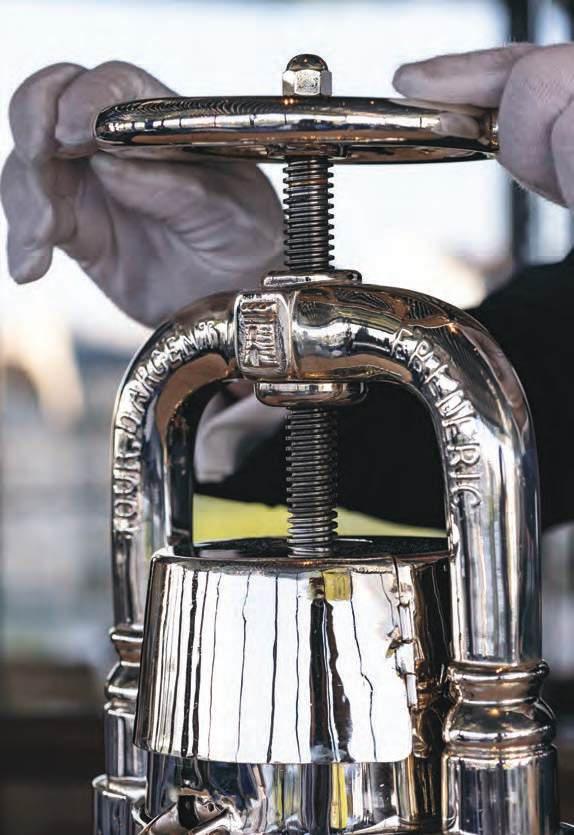
composed with clarity and confidence. Opened as a hotel in the 1830s and patronised by royalty and artists alike, Le Meurice has evolved into a dining room where every element, from the porcelain to the pacing, has been considered. Perhaps nowhere in Paris feels quite so steeped in atmosphere as La Tour d’Argent. With views across the Seine towards NotreDame and roots dating back to 1582, it carries with it stories of kings, presidents, and duck à l’orange prepared with ceremonial gravity. Its famed pressed duck
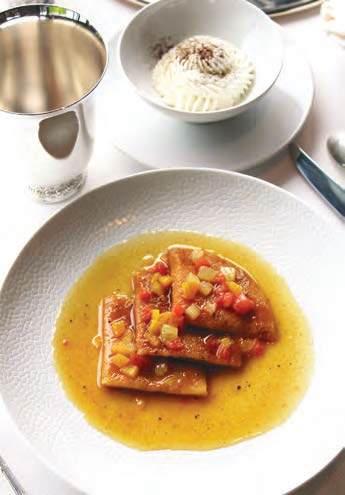
– each bird numbered and recorded in a ledger – remains the signature. The dining room, recently restored, glows in soft tones of blue and silver. There is a wine cellar here with more than 300,000 bottles. It is the kind of restaurant where the silver cutlery and hushed service don’t feel performative, but quietly earned.One can easily imagine Hemingway at a corner table, pen in pocket, absorbing the mood. He once wrote, “There are only two places in the world where we can live happy: at home and in Paris.”
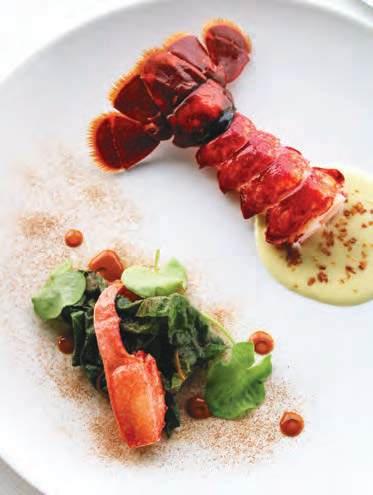
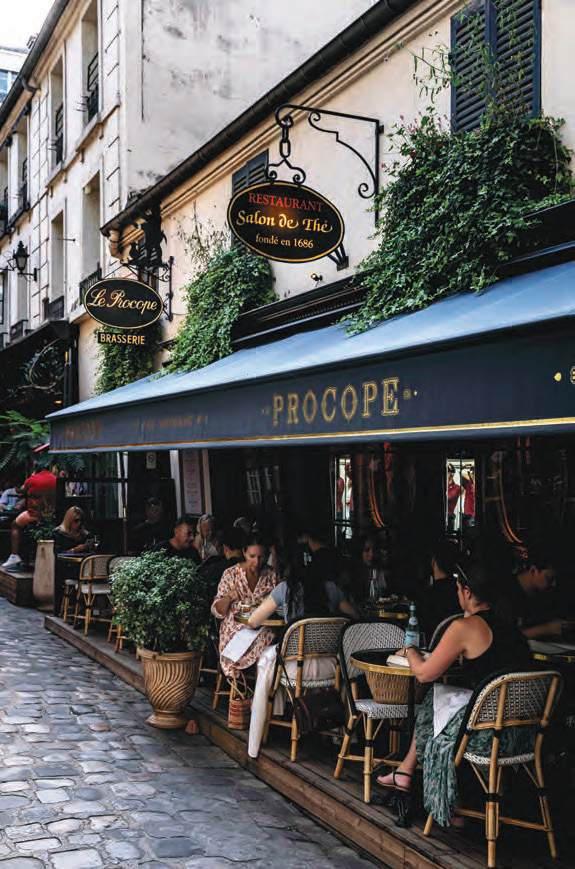

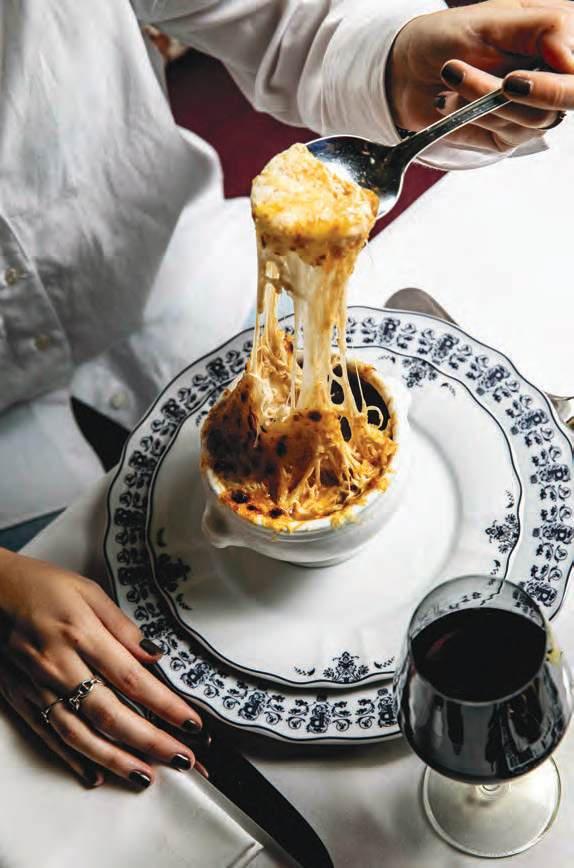
This page and facing: LE PROCOPE. Photographycourtesy Le Procope. Above left: Established in 1686, Le Procope holds the distinguished title of being one of the oldest continuously operating cafés in the City of Lights. Voltaire, Frédéric Chopin, Napoleon Bonaparte, Victor Hugo, Benjamin Franklin, Honoré de Balzac, and Jean-Jacques Rousseau have all walked through its doors. Procope was France’s first establishment to call itself a café, serving coffee and Italian gelato. Above: Parisian-style gratin onion soup, both gourmet and comforting. Left: Beef Bourguignon, with foie gras and black truffles. Facing page: Hot chocolate profiteroles with fior di latte ice cream.
And then there is Le Procope – the oldest café in Paris, opened in 1686, and once the regular haunt of Voltaire, Rousseau, and Napoleon. Its walls are hung with revolutionary pamphlets and antique clocks, and its rooms echo with centuries of political and philosophical debate. Today, diners still order coq au vin and sip café crème in an atmosphere thick with history. It is perhaps the most democratic of the historic restaurants – more accessible, more casual, but no less potent in its charm.
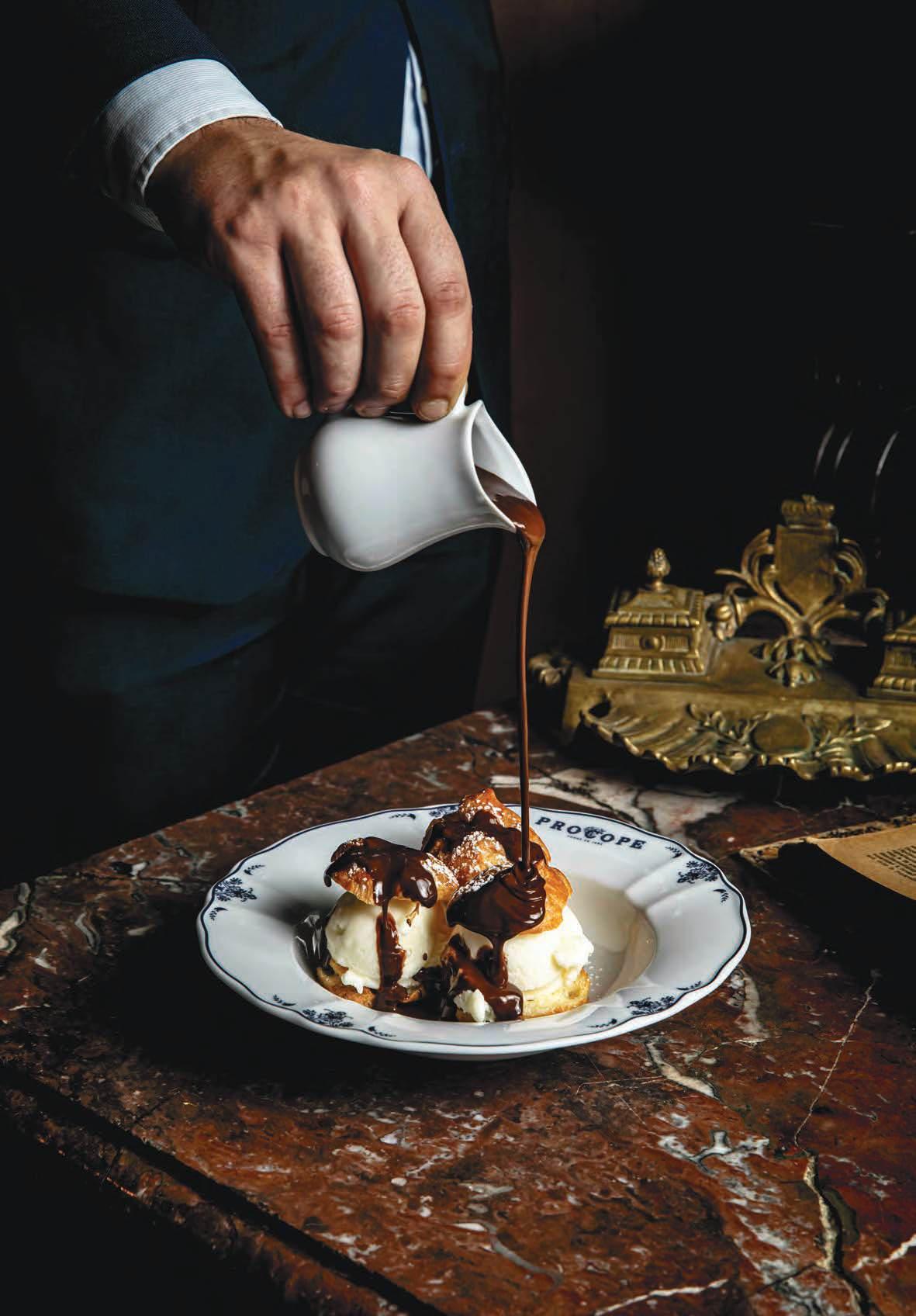
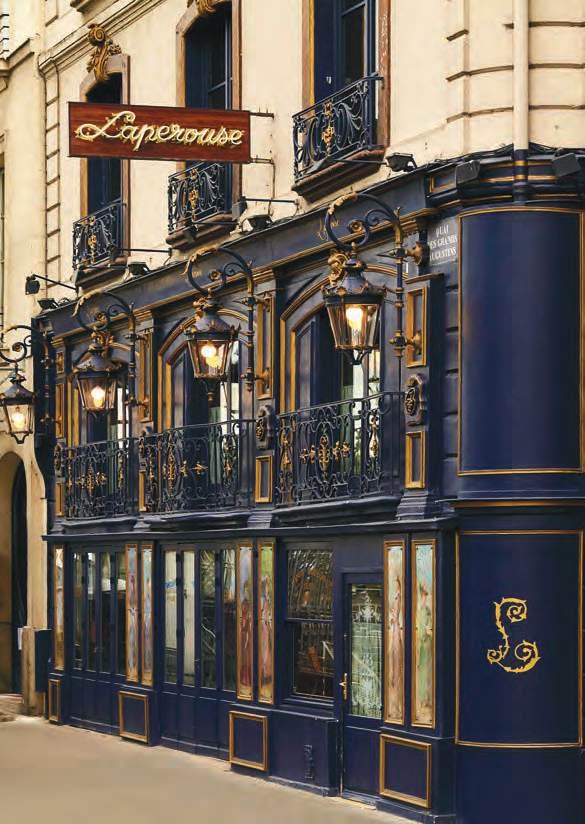

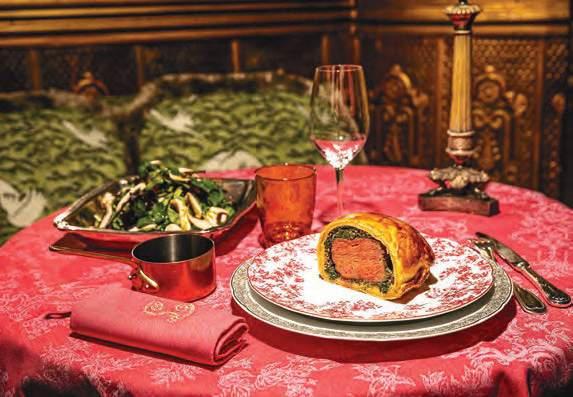
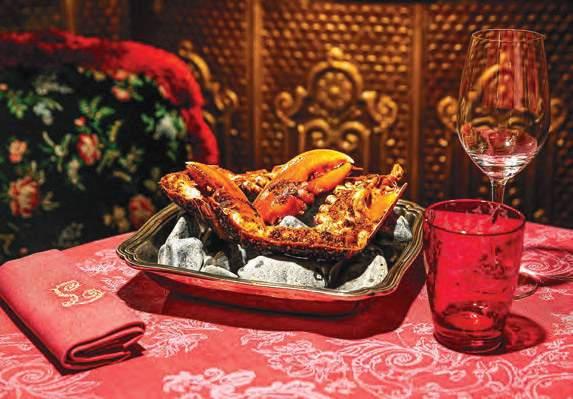
Lapérouse, too, conjures another time. First opened in 1766 as a wine merchant’s shop and evolving into a literary haunt favoured by the likes of Zola, Proust, and Colette, it is famously decadent. The private salons upstairs still feature mirrored walls scratched with the diamonds of courtesans testing the authenticity of their gifts, and the menu plays up to the indulgence: foie gras, lobster, and sole meunière. The recent renovation has preserved its shadowy glamour while ensuring the comfort meets modern expectations. Lapérouse offers an atmosphere of whispered stories and candlelit intrigue. As Anaïs Nin once said, “We write to taste life twice, in the moment and in retrospect.” Dining at Lapérouse feels not unlike that.
A shared confidencelinks these restaurants. They do not apologise for their age, nor do they attempt to erase it. They recognise that pleasure lies not only in what is new, but in what endures. Paris has always drawn people to the table. Artists, designers, politicians, and romantics have long found that the city’s true magic reveals itself when there is a bottle open, a table set, and time to enjoy both. Victor Hugo once observed, “To love or to have loved, that is enough. Ask nothing further.” The same could be said of dining here – to eat well in Paris, surrounded by beauty and history, is already a kind of love.
In these spaces, history is not frozen – it is tasted, one dish at a time.Paris remains one of the world’s great culinary destinations because it keeps the best of what has always worked. The lighting is flattering, the service is discreet, and the food is never merely decorative. These restaurants do not try to be timeless. They simply are.
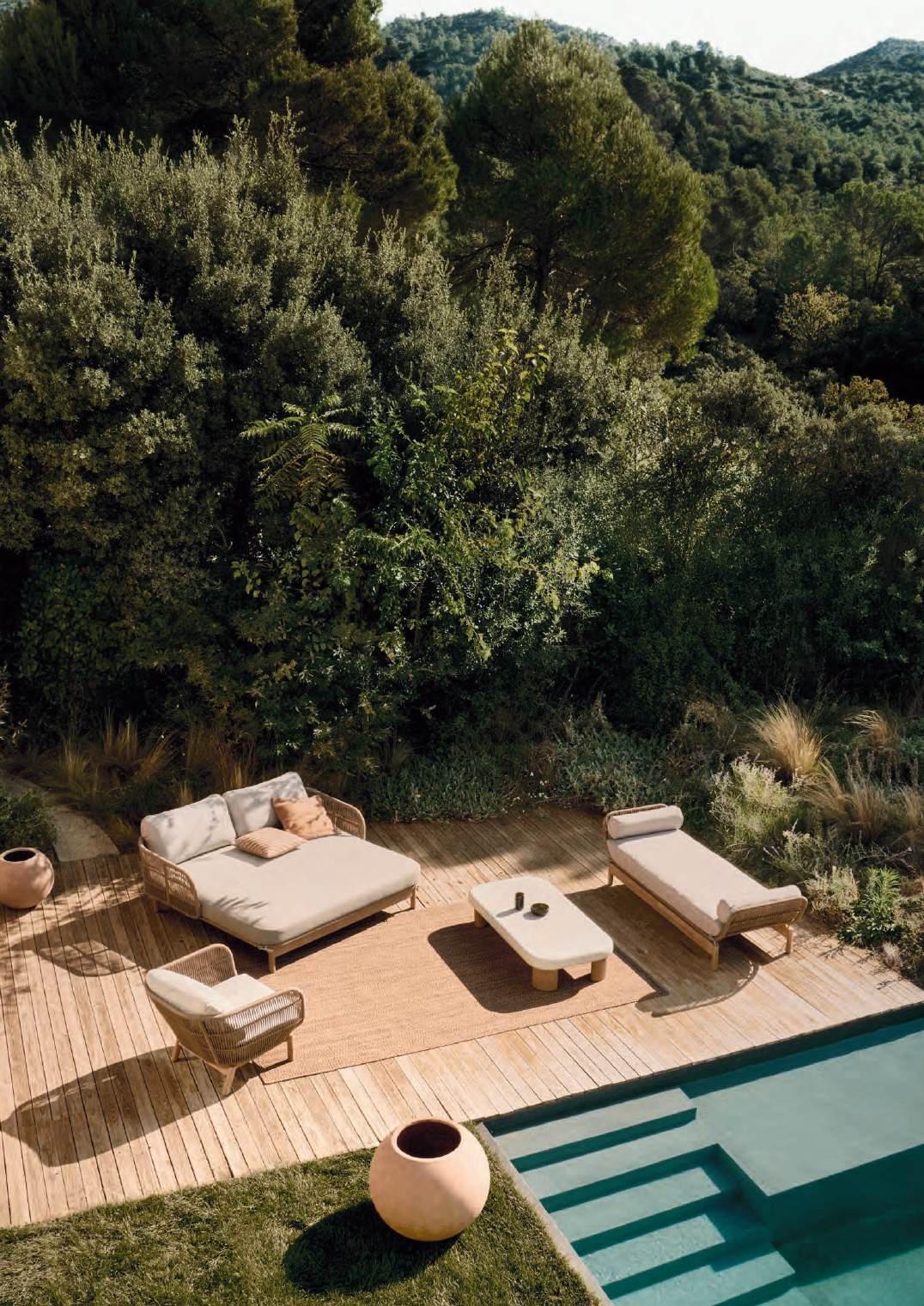

MIND OVER SUGAR: CAN REVERSING DIABETES PROTECT YOUR BRAIN?
Can cutting fat from your liver save your memory?
Groundbreaking research suggests the road to a sharper mind may begin with managing type 2 diabetes – and even reversing it.
Photography Tangerine Newt.

In a world increasingly obsessed with wellness trends and quick hacks, it’s easy to overlook the simple power of evidence-based science – particularly when it comes to two of the biggest health challenges of our time: type 2 diabetes and
dementia. Each is a formidable adversary in its own right, but what’s now becoming alarmingly clear is the tangled link between the two. The good news? We’re not powerless – not even close.
fundamentally reshaped our understanding of type 2 diabetes, debunking the onceunquestioned notion that the disease is a lifelong condition. Thanks to over a decade of clinical trials and imaging studies, Professor Taylor has shown that, for many, remission is not only possible – it’s achievable without medication. THE LONG GAME
At the heart of a revolution in diabetes research is Professor Roy Taylor of Newcastle University. His work has



The key lies in reducing the body’s internal fat burden.
According to Professor Taylor, “People have a personal fat threshold. When you go above that threshold, fat spills into places it shouldn’t be – most damagingly into the liver and pancreas.” The pancreas, clogged with fat, can no longer produce insulin efficiently. But, crucially, that damage isn’t permanent. Through significant weight loss – often just 10-15% of body weight – this fat can be cleared, and the pancreas can recover. The landmark DiRECT trial, co-led with Professor Mike Lean, found that nearly half of participants were in remission one year after following a low-calorie, nutrientcomplete diet, and many remained in remission two years on.
Yet while the physical benefits of reversing
diabetes are clear, what’s increasingly under scrutiny is the disease’s impact on brain health. It’s no longer simply about managing blood sugar. It’s about safeguarding cognitive function, too.
According to Dr Andrew E. Budson of Harvard Health Publishing, “More recent studies have shown that diabetes also increases your risk of dementia.” Writing in 2021, he drew attention to research examining the age of diabetes onset and its bearing on dementia risk. “These striking results clearly show that the earlier you develop diabetes, the greater your risk is for developing dementia,” he wrote. The data, gathered from a long-term cohort study in London, showed dementia rates rising dramatically in those with diabetes from mid-life onwards – with rates nearly doubling in those who had the condition for more than ten years by age 70.
The relationship between diabetes and
dementia is complex but sobering. Damage to the heart and blood vessels – common in poorly controlled diabetes – also compromises blood flow to the brain, raising the risk of vascular dementia. High blood sugar itself can cause inflammation, microvascular damage, and even hypoglycaemic episodes, all of which take their toll on brain cells.
And then there’s the theory – still under investigation, but gaining ground – that type 2 diabetes may directly contribute to the development of Alzheimer’s disease. Insulin, it turns out, plays a vital role in brain function. Dr Budson notes that “insulin plays a critical role in the formation of amyloid plaques, and insulin is also involved in the phosphorylation of tau, which leads to neurofibrillary tangles” – both of which are hallmarks of Alzheimer’s pathology. It’s no wonder some scientists refer to the disease, unofficially, as ‘type 3 diabetes.’

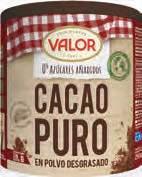














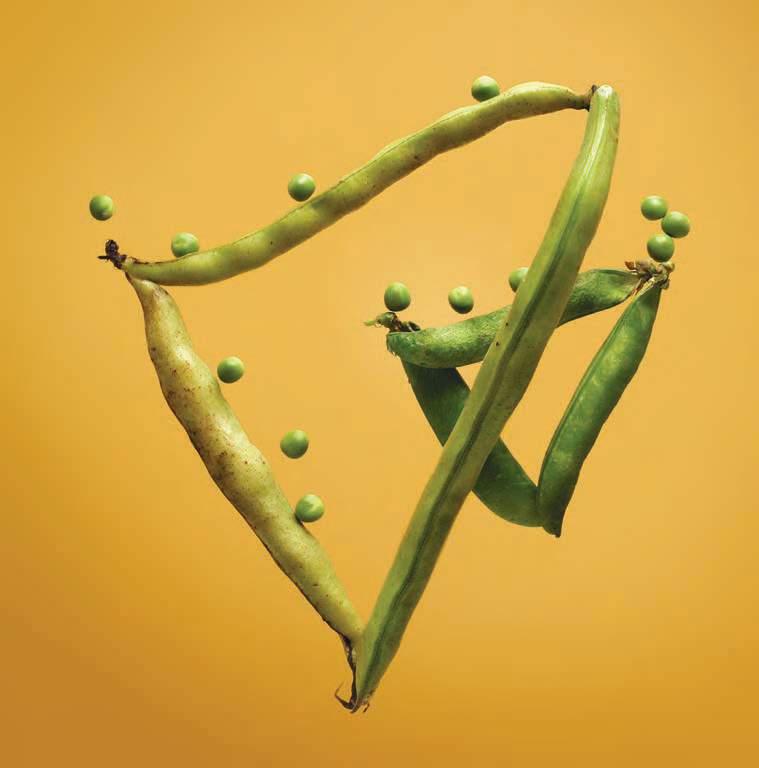


Alzheimer’s Society UK underscores this connection, pointing out that insulin resistance in the brain may lead to a build-up of the same amyloid and tau proteins that disrupt brain cell function in Alzheimer’s.
Furthermore, people with diabetes are often more likely to experience other dementia risk factors: high blood pressure, high cholesterol, and obesity, compounding the threat.
But if the picture seems bleak, it needn’t be. Just as diabetes remission is now an achievable goal, so too is reducing the risk of cognitive decline. “A lifelong approach to good health is the best way to lower your risk of dementia,” says the Alzheimer’s Society. Their advice, while unglamorous, is remarkably effective: eat a balanced diet, get regular exercise, don’t smoke, and keep alcohol intake in check.
Professor Taylor’s work underscores just how powerful those lifestyle changes can be. His approach focuses not on shortterm fixes but on sustainable weight management and informed food choices. His 2020 book, Life Without Diabetes, offers a practical blueprint for people looking to reverse the disease and improve their overall metabolic health – a move that may very well protect the brain in the process.
Pharmacological treatments may also play a role. Research from Alzheimer’s

Research UK highlights that people with type 2 diabetes taking metformin – a common anti-diabetic medication – have shown lower rates of dementia in some studies. Other diabetes drugs are being evaluated for their potential neuroprotective effects, although the results so far are mixed and require further large-scale trials.
Still, the fundamental message remains consistent across research bodies. “We can take steps to reduce our risk of getting type 2 diabetes,” notes Alzheimer’s Research UK, “and these things are important for people who already have the condition too. In turn, these things also reduce our risk of dementia.”
Here in Malta, where rates of type 2 diabetes are among the highest in Europe, this knowledge is particularly relevant. The conversation about diabetes needs to move beyond finger-prick tests and glucose monitors to include long-term brain health and quality of life. With people living longer than ever, protecting cognitive function is not a niche concern – it’s the cornerstone of ageing well.
Of course, lifestyle change isn’t always easy. But for those willing to take the first step, the rewards are profound. As Professor Taylor has shown, remission is within reach. And as the growing body of research reveals, the sooner we act, the better the outcome – not just for our bodies, but for our minds.
After all, the future of brain health may well begin in the pancreas.


“Fashion becomes unfashionable. Style never.”
Gabrielle Chanel
CHANEL’s CHANCE fragrance line has always danced to the rhythm of spontaneity. Joyful, bright and distinctly modern, it defies conventional structures, offering instead an effervescent composition that feels as free-spirited as it does refined. The latest addition to this emblematic collection, CHANCE EAU SPLENDIDE, brings a fresh radiance and olfactory elegance that could only come from the imagination of Olivier Polge, CHANEL’s in-house Perfumer-Creator since 2015.
Photography courtesy CHANEL.
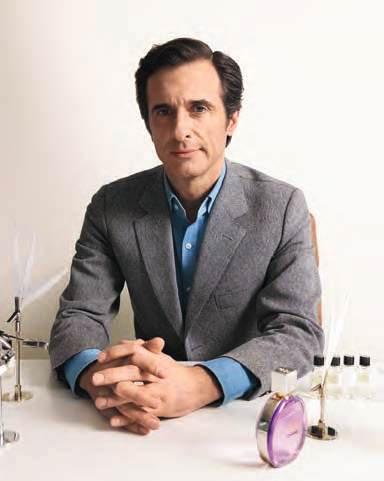
CHANEL’s CHANCE fragrance line has always danced to the rhythm of spontaneity. Joyful, bright and distinctly modern, it defies conventional structures, offering instead an effervescent composition that feels as free-spirited as it does refined. The latest addition to this emblematic collection, CHANCE EAU SPLENDIDE, brings a fresh radiance and olfactory elegance that could only come from the imagination of Olivier Polge, CHANEL’s in-house PerfumerCreator since 2015.
“There are no rules in perfumery,” Polge reflects. “The idea is to bring out an emotion or an individual experience that resonates beyond gender and age.” It’s this democratic sense of beauty –intimate, intuitive, instinctive – that fuels the spirit of CHANCE. At CHANEL, fragrance begins not with a formula, but with a state of mind. Gabrielle Chanel herself saw chance not as happenstance but as an attitude, a way of perceiving and pursuing possibility with fearless grace.
CHANCE EAU SPLENDIDE was born of “a playful and carefree state of mind,” Polge explains, “tinged with freshness and optimism.” In developing this newest iteration, he was guided by the vivacity that connects the CHANCE family: a shared sense of movement, of joy made tangible through scent. But CHANCE EAU SPLENDIDE offers its own distinctive signature – a fruit-forward radiance made striking through the inclusion of an inventive raspberry accord. “For this new interpretation, I wanted to construct its characteristic freshness with something innovative, an uncharted accord. It allows a remarkable opening, undoubtedly the fruitiest in the line. That is how we obtain this immediate feeling of comfort and elegance, as well as a very vivid sparkling impression.”
Such lightness is carefully balanced. “It was essential that nothing darken the structure,” he notes. To achieve that luminous tension, Polge turned to rose geranium – a key floral element also cultivated by CHANEL in their fields in Grasse. “It adds contrast to the fragrance so that it is fruity without being too sweet… enveloping, yet remains fresh.” Violet and rose facets lend dimension, while geranium introduces an aromatic clarity that prevents the composition from tipping into indulgence. Each CHANCE fragrance is given its own
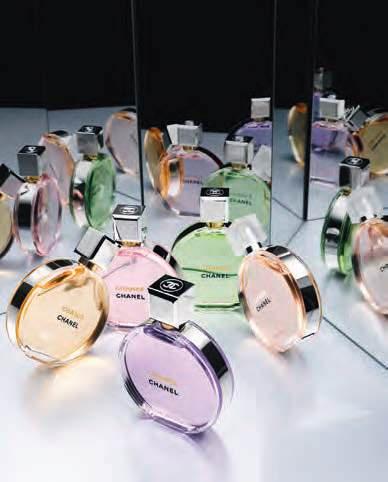
colour identity, and for CHANCE EAU SPLENDIDE, purple emerged instinctively. “After completing the formula, we smelt the fragrance. Purple came to mind naturally, almost instinctively. It conveys the fresh and fruity impression of the raspberry accord, and also expresses the more mysterious and complex floral aspect of the fragrance.”
The son of legendary CHANEL perfumer Jacques Polge, Olivier brings a thoughtful lyricism to his creations, shaped by a background in music and art history. “When I started learning the trade, I discovered that music and perfume shared the same language. I was going to have to compose and write formulas made of notes and chords.” His work with CHANEL draws from this artistic discipline, producing perfumes that are as emotionally resonant as they are technically refined.
Joyful, colourful, spontaneous – CHANCE EAU SPLENDIDE speaks to a world in motion. “Wearing a fragrance means choosing an extremely personal signature scent… it provides power and gives you freedom,” Polge says. “It is an accessory that makes you feel good… ideal for creating chance or simply daring to seize it!”
CHANEL is distributed by Alfred Gera & Sons Ltd.
